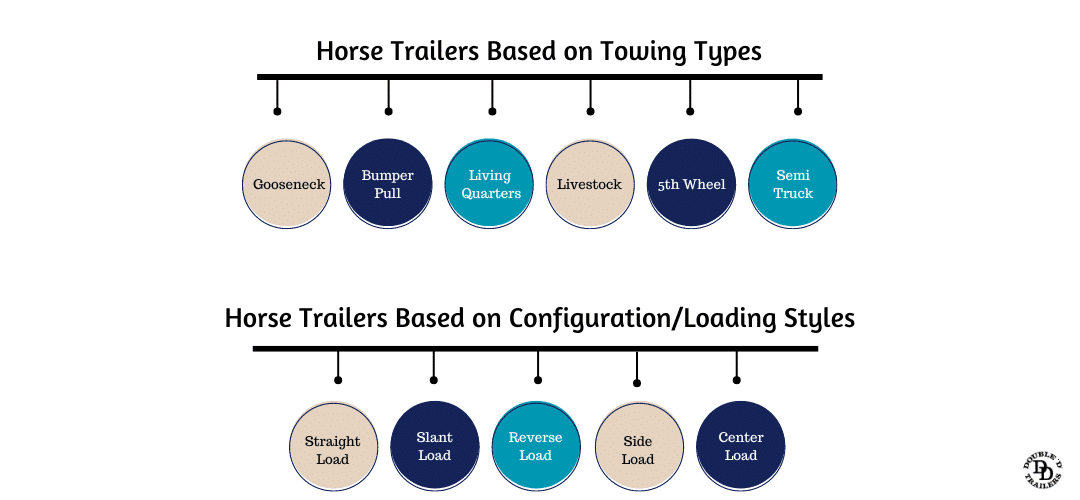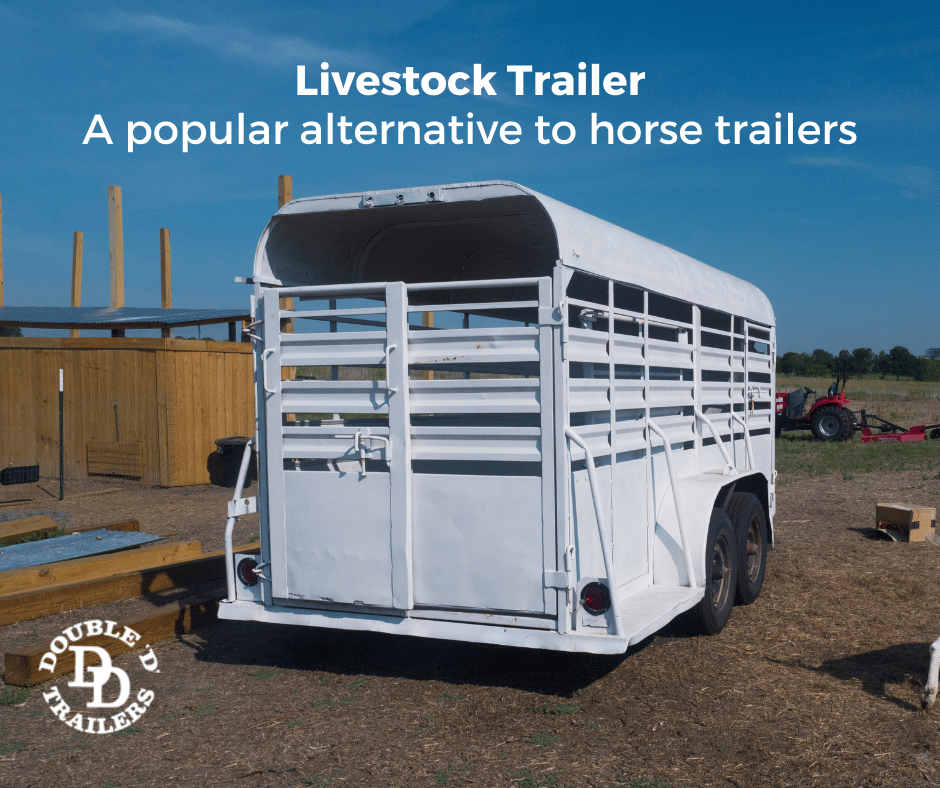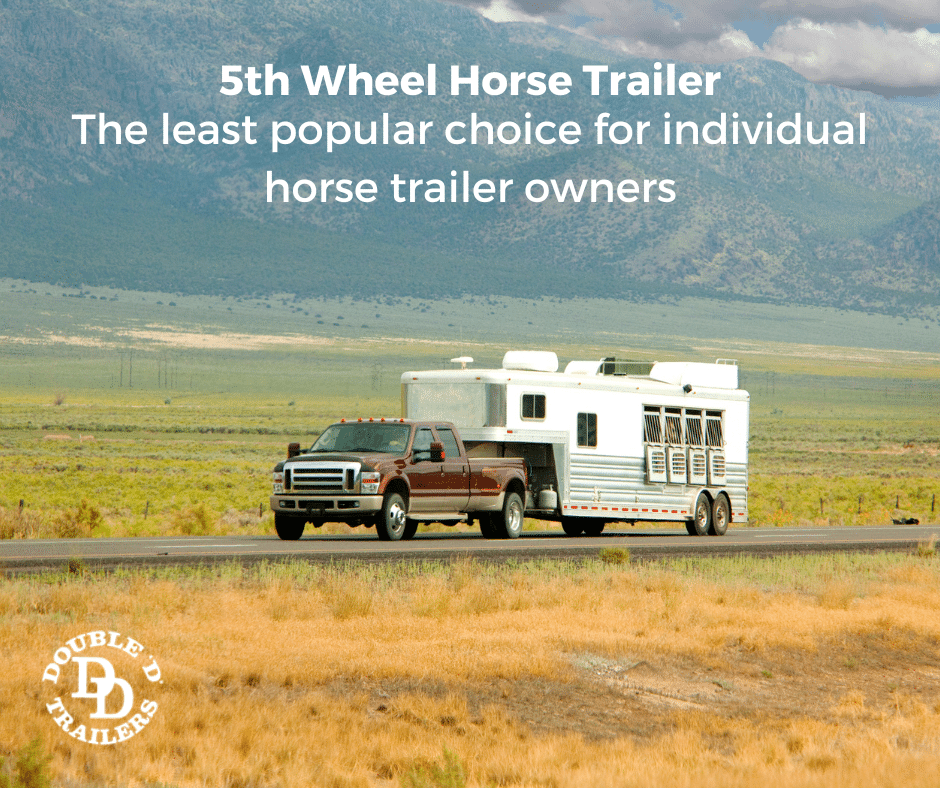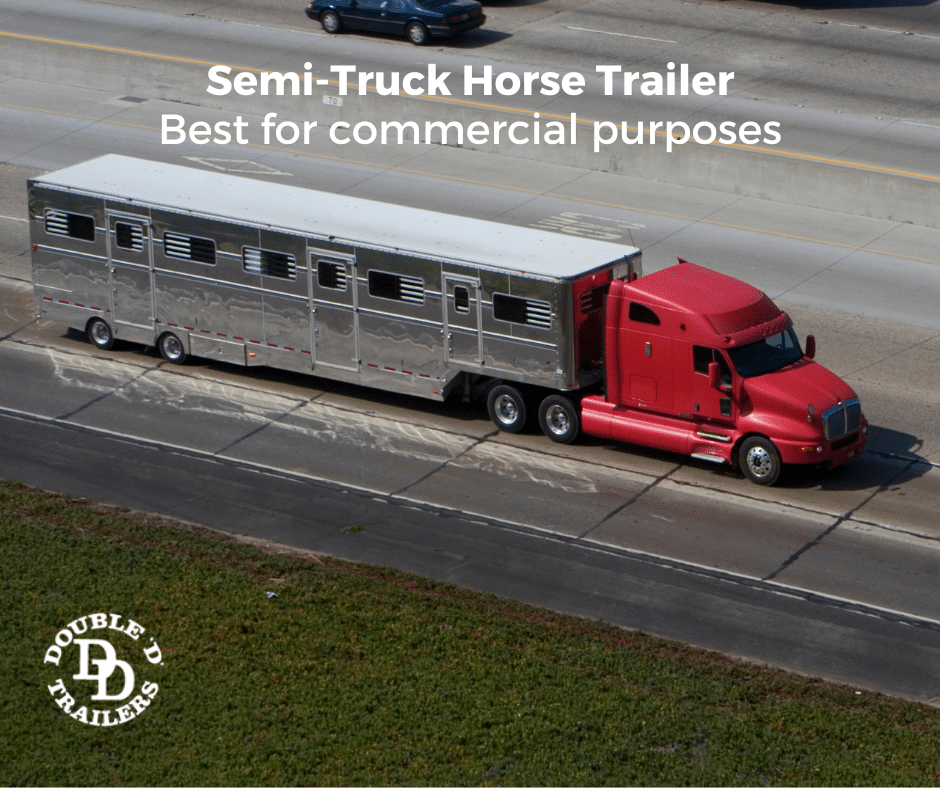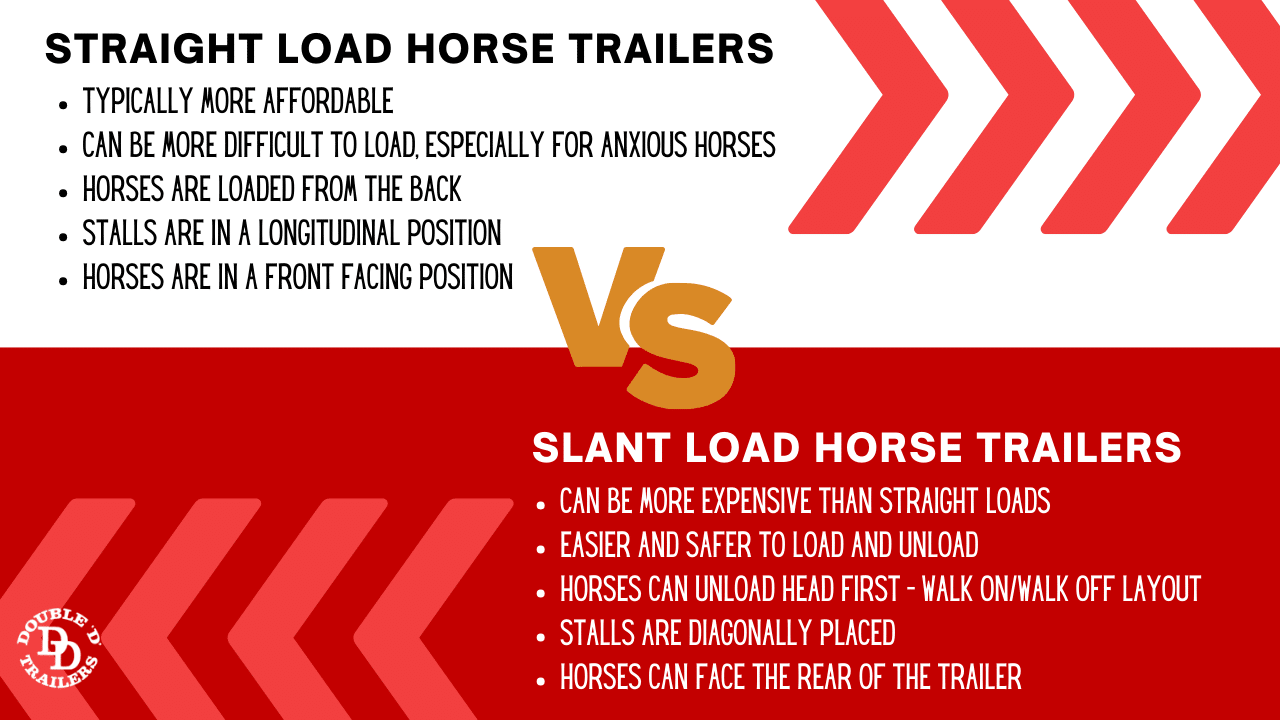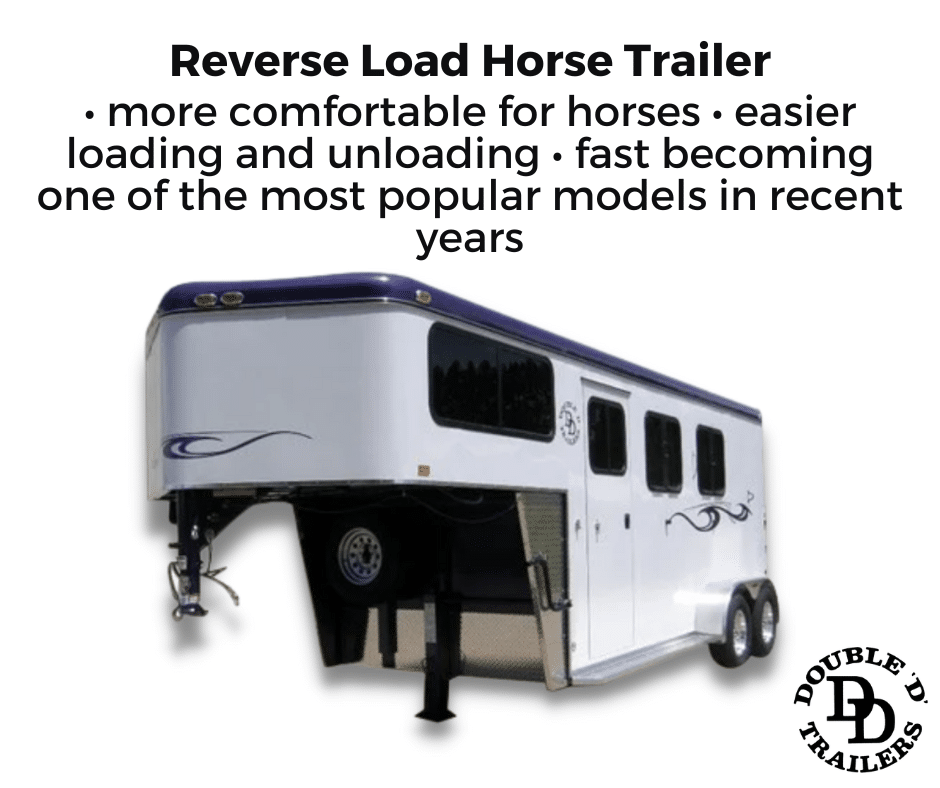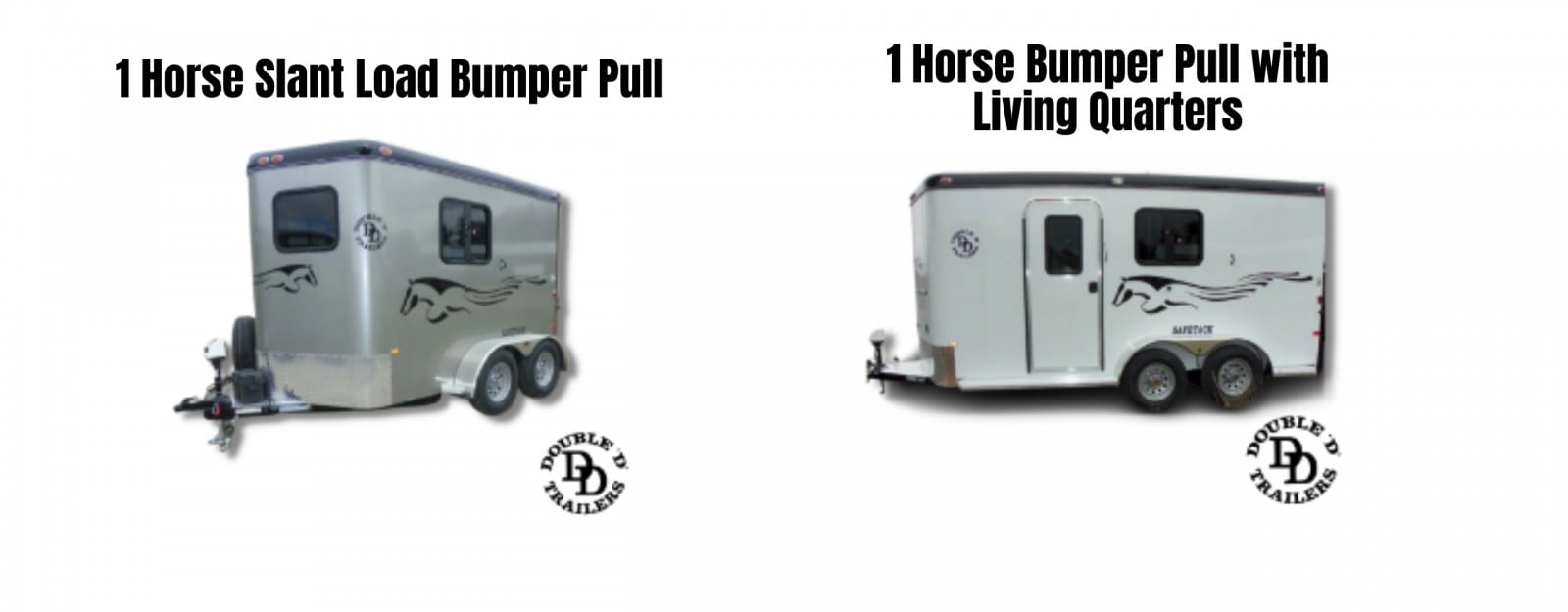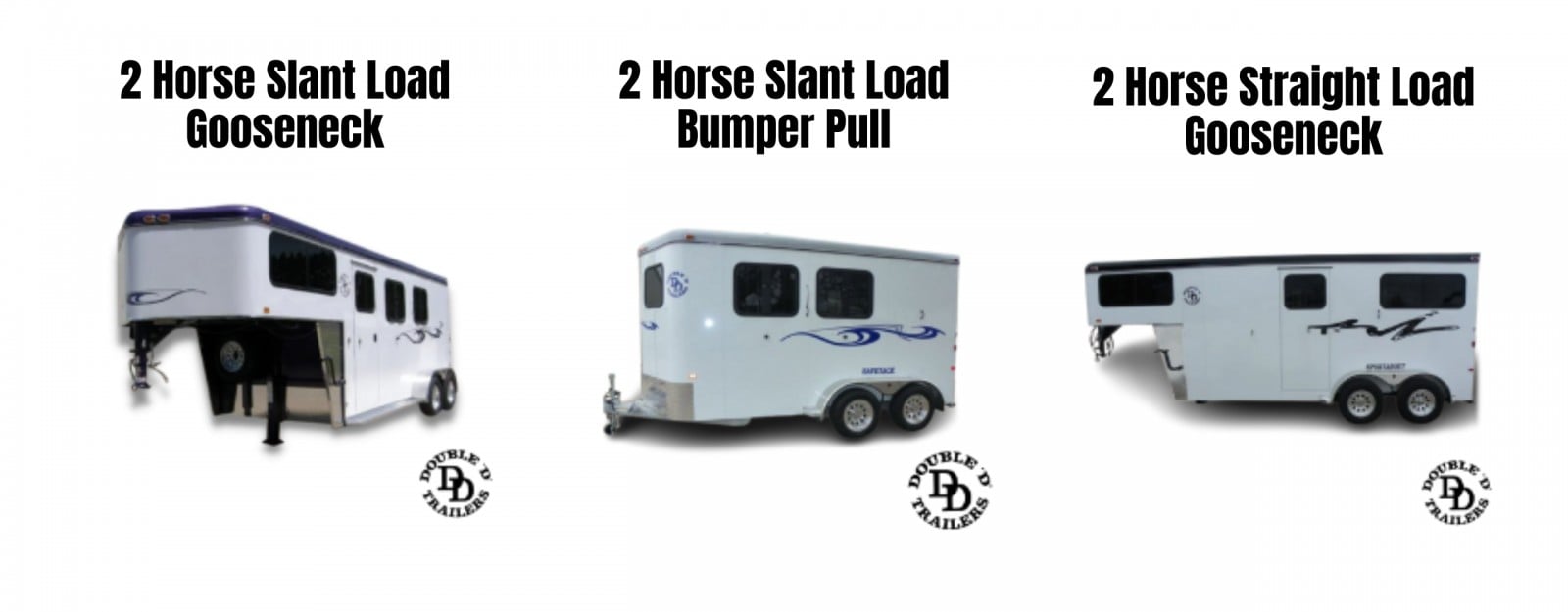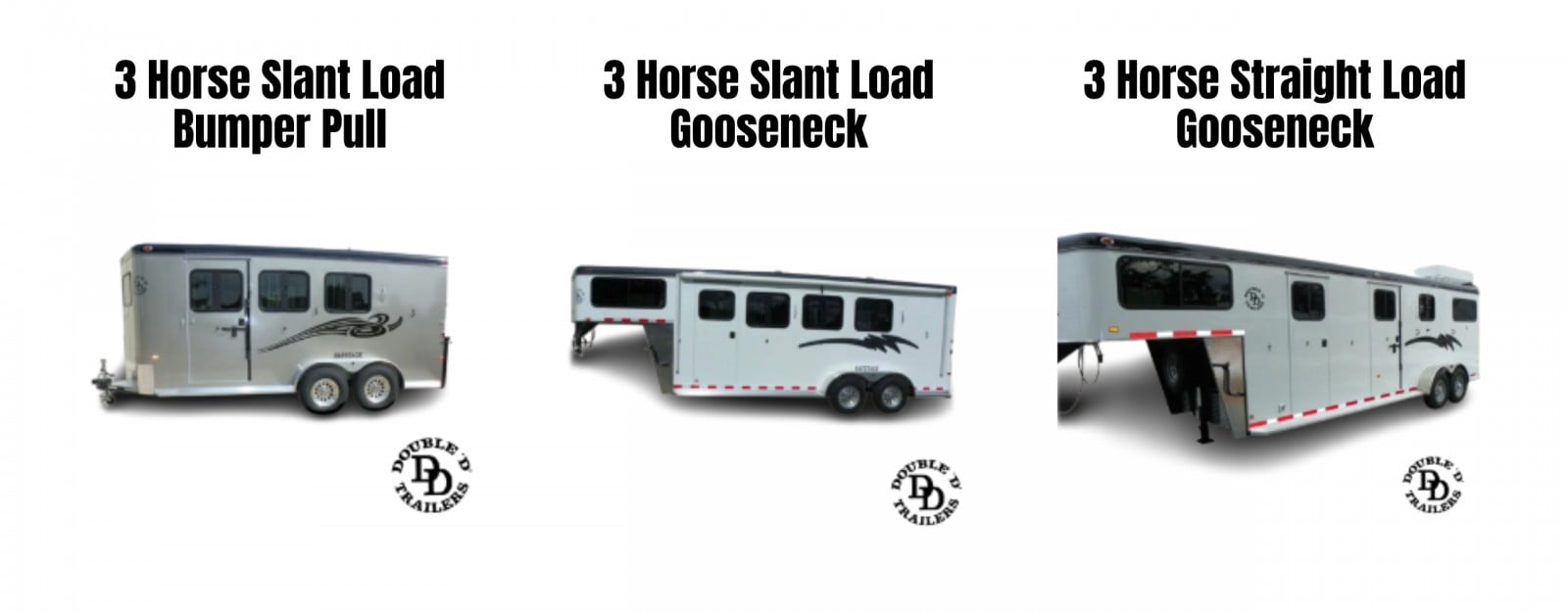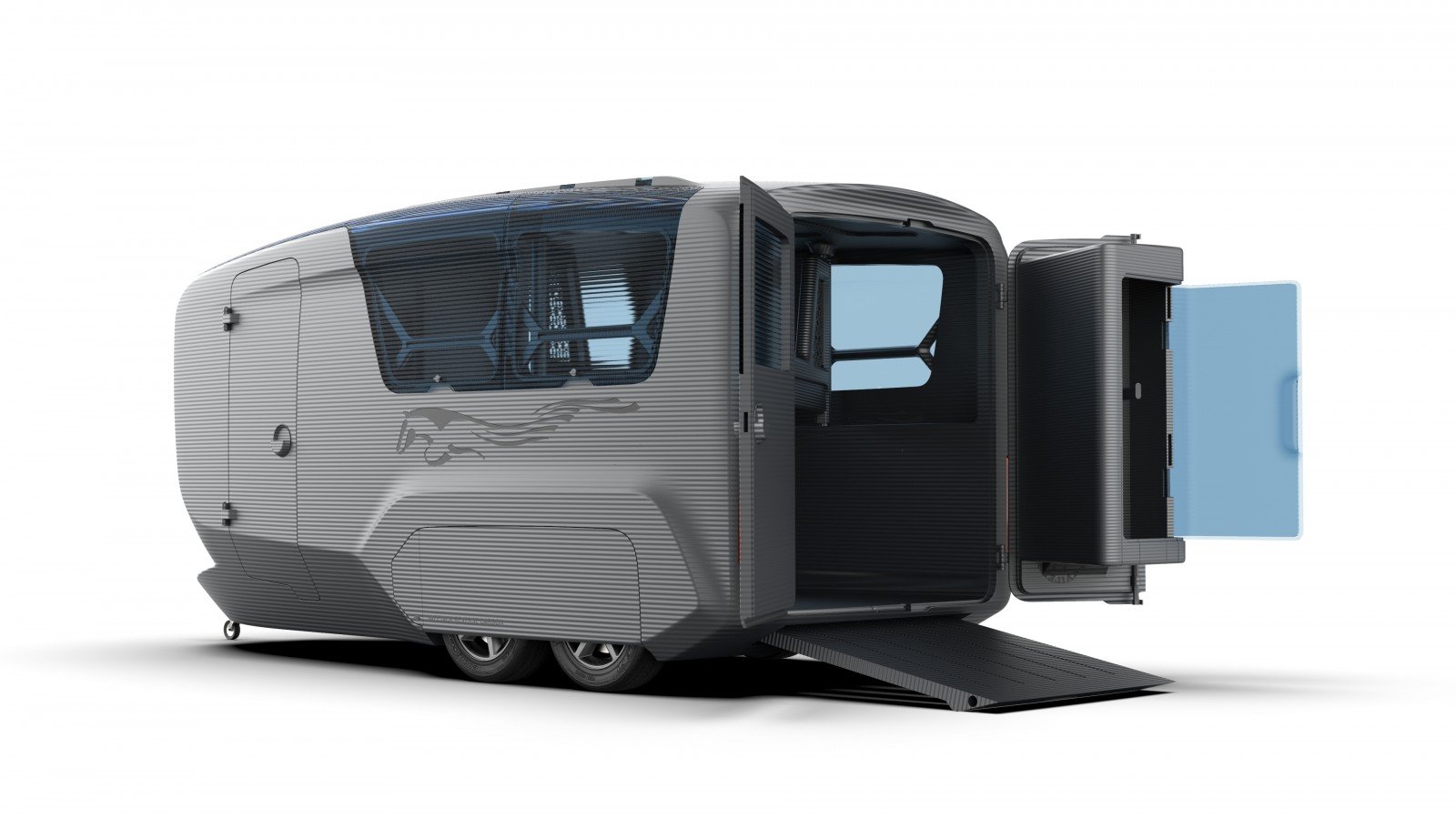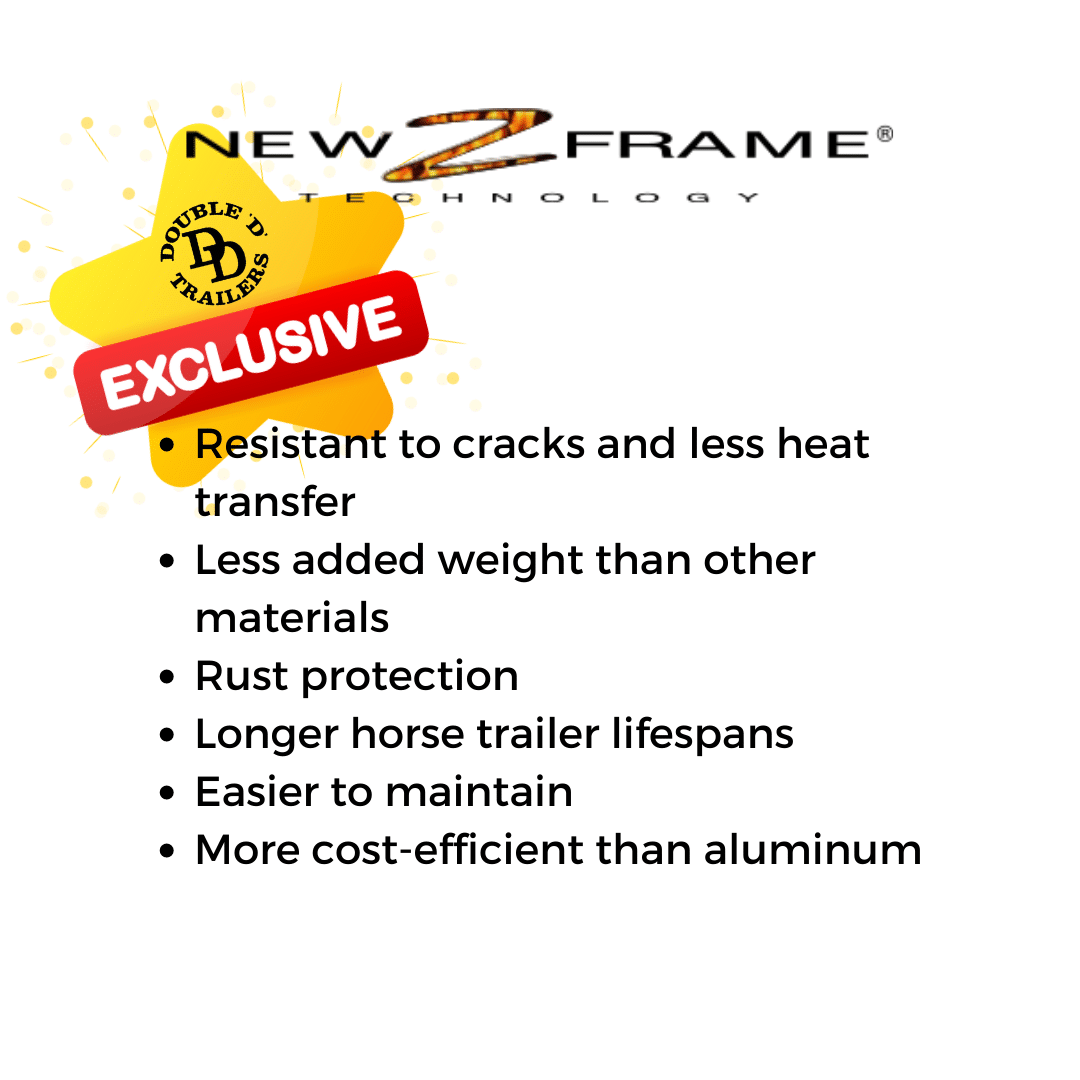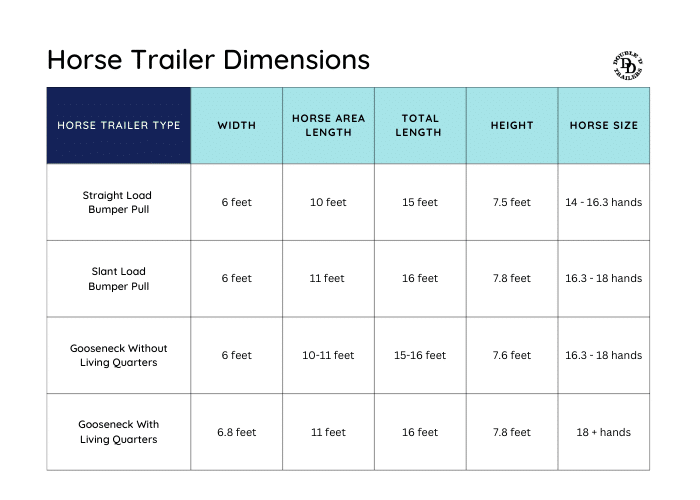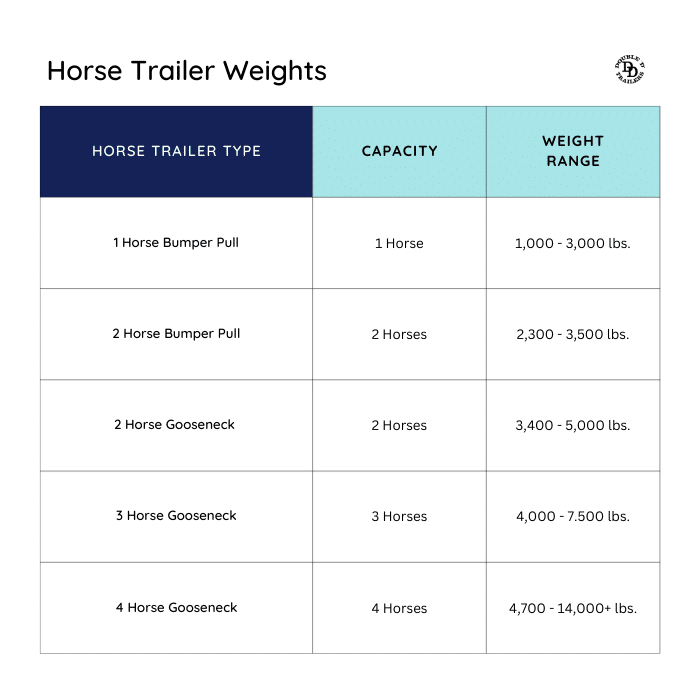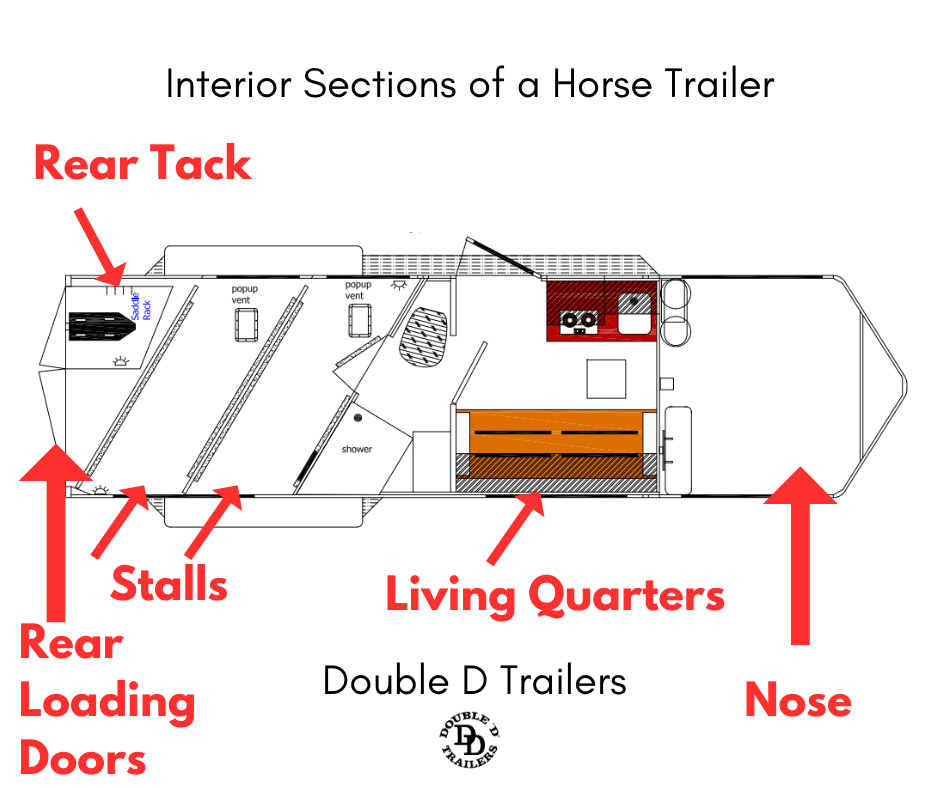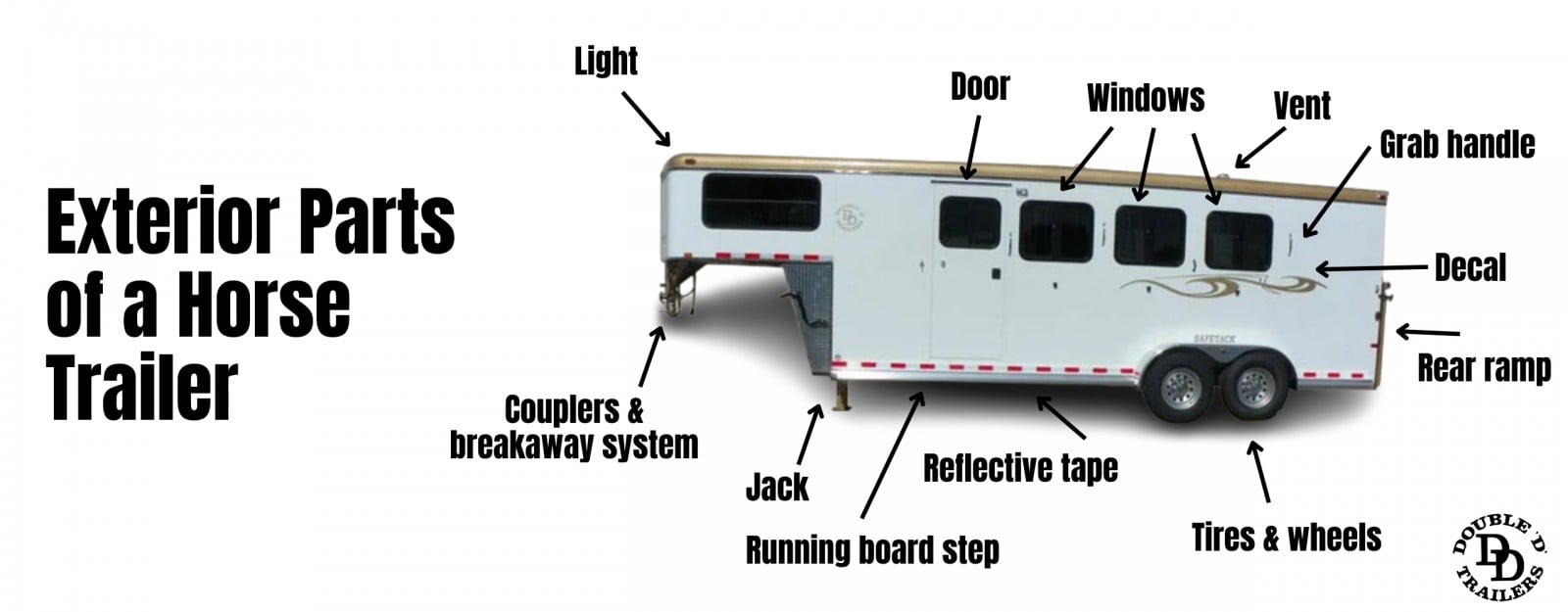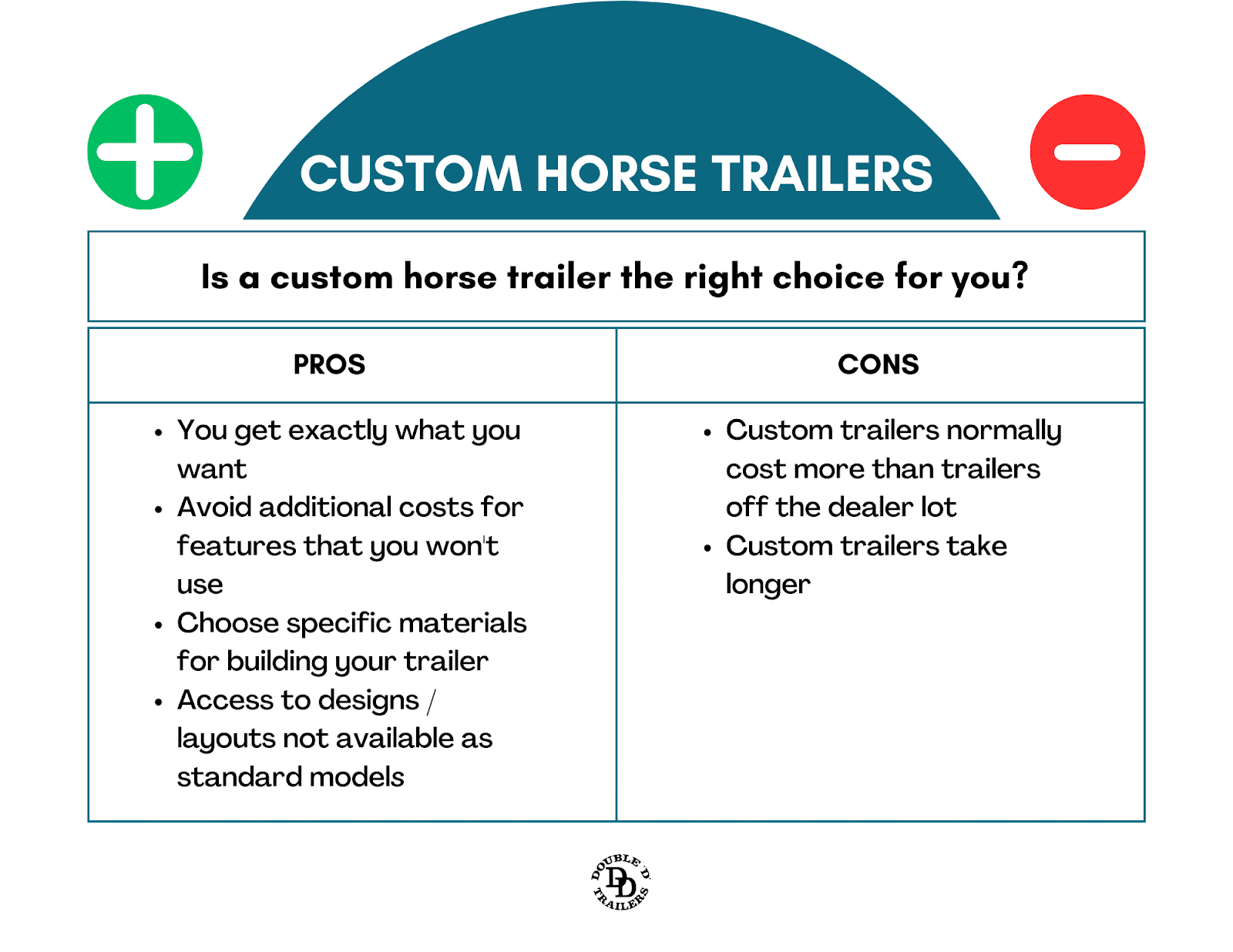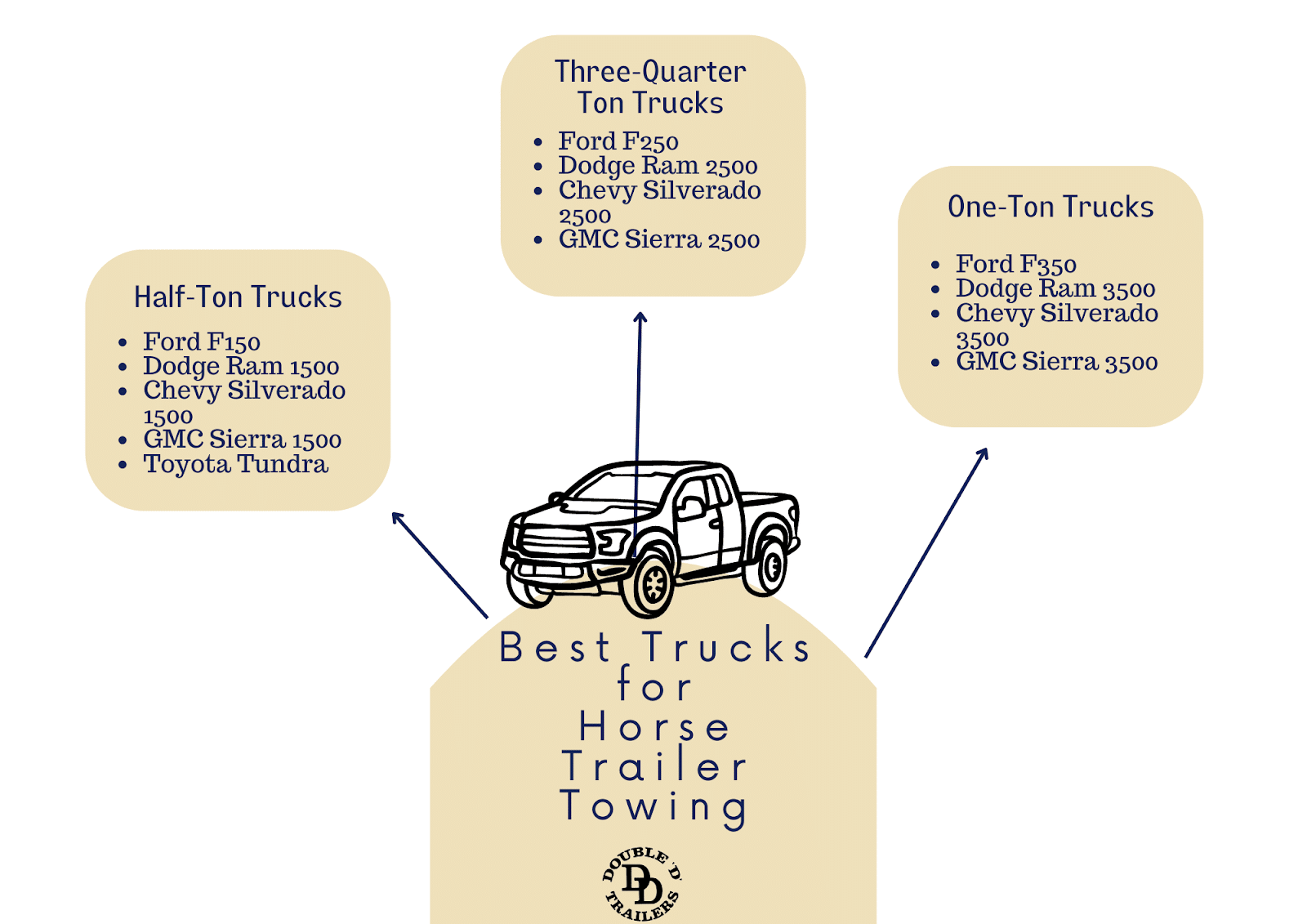Key Things to Know Before Buying a Horse Trailer
Buying a horse trailer is a major decision-making endeavor: it entails shelling out a significant amount of cash and committing to the long-term responsibilities of horse trailer ownership. Searching for the most suitable horse trailer, therefore, requires thoughtful consideration of crucial elements, such as its purpose, type, cost, safety standards, construction materials, dimensions, licensing requirements, and distinctive features. Even knowing its history plays some part in the shopping journey. This comprehensive guide to horse trailers includes all the essential knowledge you need to make a well-informed decision, saving you from a potentially costly investment mistake.

What is a Horse Trailer?
A horse trailer is specifically designed to guarantee safe horse transportation and provide maximum comfort for the animals while on the go. It is typically towed by a pickup truck or other suitable vehicle, such as an SUV. Horse owners, farmers, professional equestrians, trainers, and veterinarians are among those who need and use horse trailers.
Also referred to as “horse box” in the UK and “horse float” in Australia and New Zealand, a horse trailer comes in various configurations and sizes based on horse capacity, hitch type, load type, and other factors and features, such as living quarters or tack rooms. The most widely used horse trailer types are bumper pull, gooseneck, and living quarters (LQ) trailers.
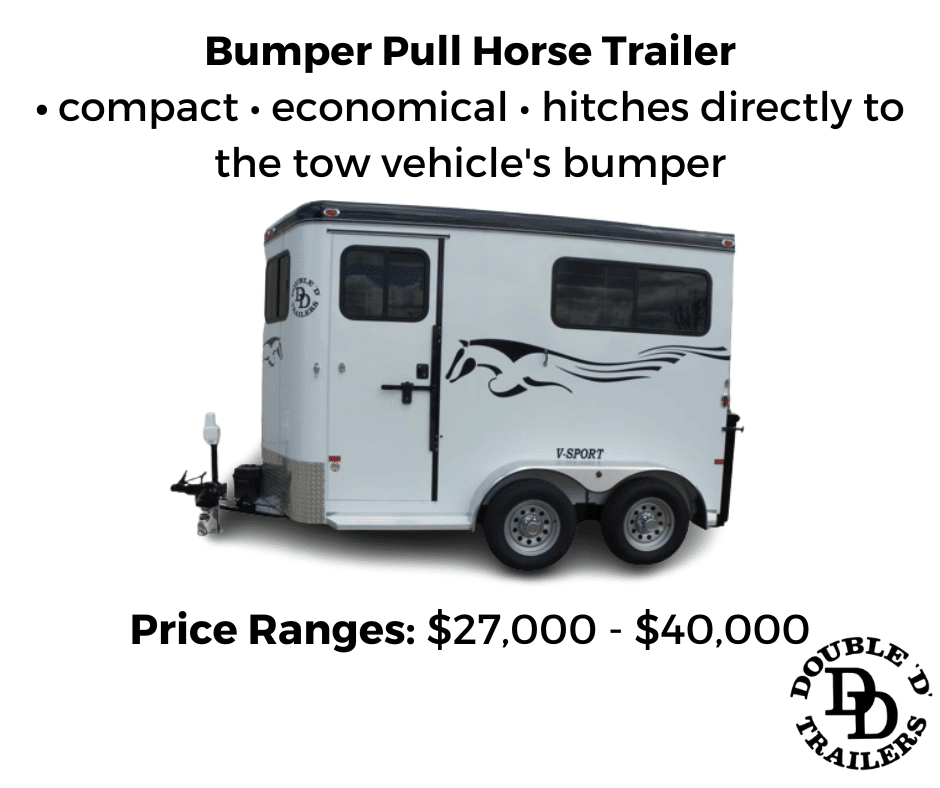 |
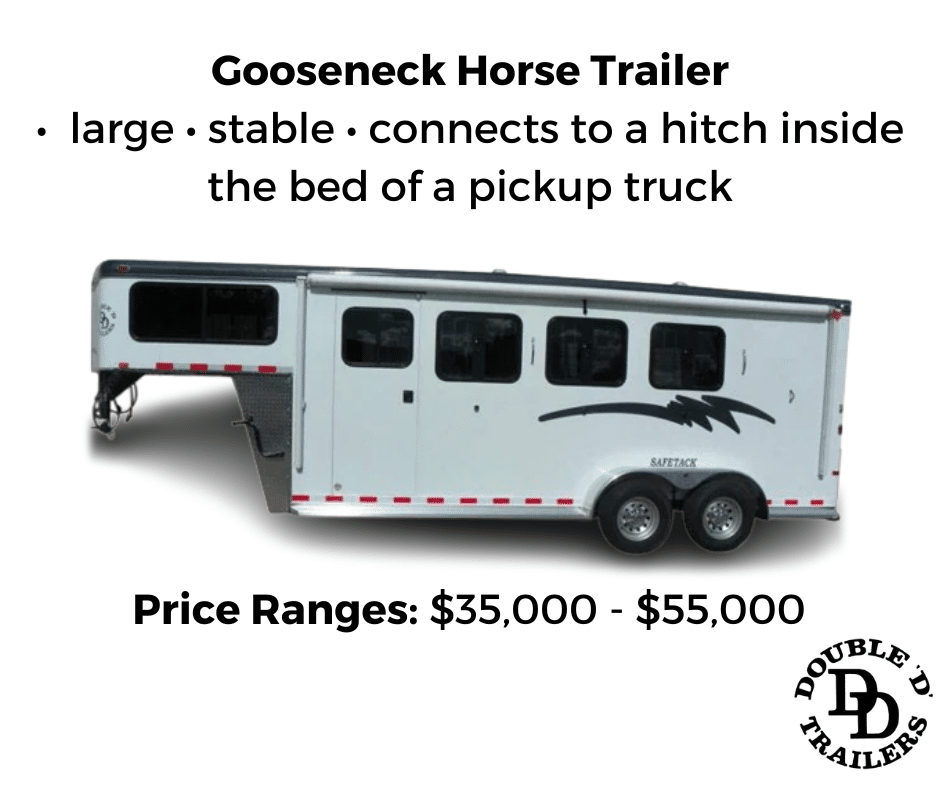 |
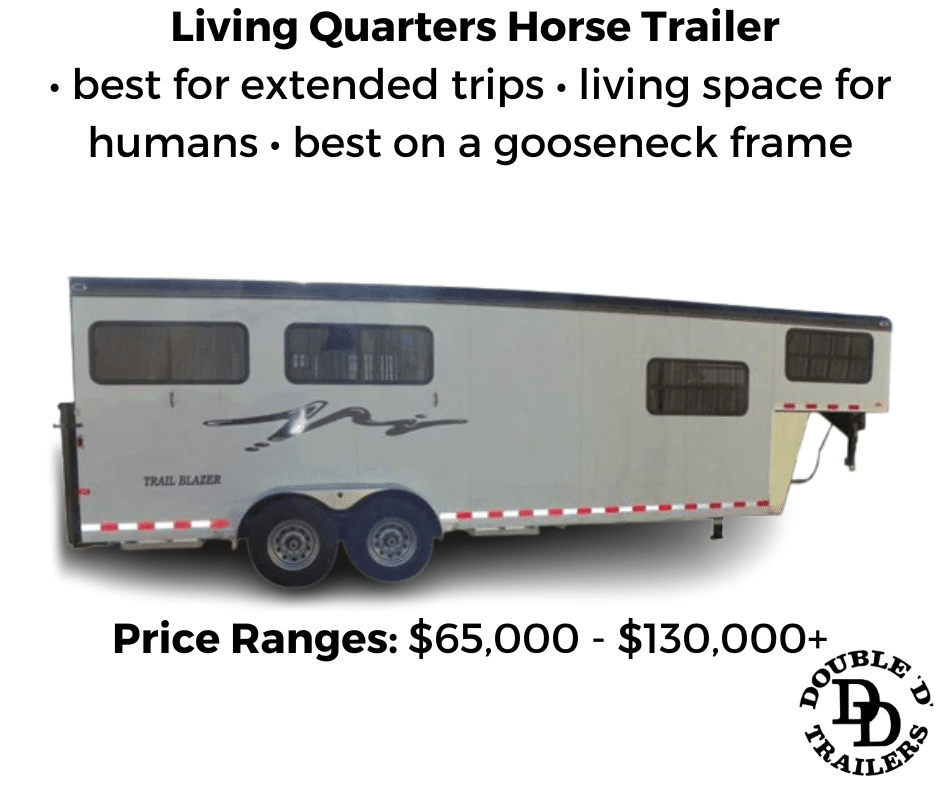 |
Depending on the particular configuration, a horse trailer’s price can vary a lot: some new ones, such as basic stock trailers, can cost less than $15,000, while full living quarters horse trailers can cost well over $200,000.
We've crafted this comprehensive guide to prepare prospective horse trailer owners for what to expect and the responsibilities of owning a horse trailer. Leverage it in your quest for the best horse trailers for sale to streamline your buying decision.
While there are numerous horse trailer types, the most prevalent are the bumper pull, gooseneck, and living quarters.
Why Buy a Horse Trailer: 6 Common Horse Trailer Purposes
A potential owner's journey starts with identifying the purpose for buying a horse trailer. Do you really need to buy one? Why? How often do you need to use it? It also helps to know the most common uses of a horse trailer.
You may find yourself identifying with one or a combination of these purposes.
1. Scientific and Animal Welfare Purposes
The importance of choosing well-designed, quality-built, comfortable, and safe horse trailers becomes vital when we consider the natural flight instincts of horses and their potential perception of confinement and transportation as threats, inducing stress. The right horse trailer could help habituate horses and train them in new behavioral patterns when they face an environment that was previously unknown to them.
Based on the research conducted by J. Yngvesson and Emelie de Boussard on “Behaviour of horses and horse owners during loading and habituating”, a properly designed horse trailer can turn the loading and transportation of horses from a burden to a regularly performed, effortless task.
The scientific purposes of a horse trailer also include the physics involved in horse transportation, such as the impact of motion on horse balance and stability.
2. Equestrian Purposes
Horse trailers, specifically designed to cater to the rigorous travel demands of professional horse riders, play a crucial role in the equestrian world. These riders often spend most of the year preparing for events and journeying to various locations, requiring transportation solutions that ensure safety and efficiency for short- and long-distance travel. Therefore, the importance of a well-designed horse trailer that meets their needs and expectations cannot be overstated.
3. Veterinary Purposes
From a veterinary perspective, horse trailers serve as an essential means of transporting horses or donkeys, given their size, which isn't possible with conventional transportation methods. They are frequently used to bring animals to vet clinics for treatment or even to deliver medical services to the horse on-site. It's important to note that not all horse owners need or own horse trailers, meaning that veterinarians need to provide such transportation when needed.
The design and operation of the trailer must account for scenarios where a sick or injured horse has to be moved. The trailer environment can also impact the horse's health, such as ventilation affecting respiratory health or standing position influencing musculoskeletal stress.
4. Road Safety Purposes
In terms of road safety, horse trailers serve as specialized vehicles engineered to transport horses securely and help them avoid neophobic behaviors leading to anxiety during hauls. These trailers aim to ensure not only the animals' safety but also adherence to established road safety standards, covering aspects such as braking systems, lighting and signaling systems, structural integrity, and weight capacities.
A quality-made horse trailer can save the horses’ lives in a road accident when its design and manufacture involve meticulous engineering and careful material selection, ultimately creating a vehicle that prioritizes both road safety and the comfortable, safe transportation of horses.
5. Business Purposes
Horse transportation companies have shaped a profitable business niche that enables other business activities like horse shows, equine sports, breeding operations, and veterinary services. Horse owners and handlers often use the services of horse transportation companies when they want to reduce hauling costs or don’t own trailers.
As equestrian people realize the need for horse trailers more and more, a growing rental market is already here to respond to their needs. There are plenty of places to rent a horse trailer from. Investing in a horse trailer is pointless if you don’t need it often.
Horse trainers and horse racing teams also use horse trailers to run their businesses.
6. Legal Purposes
Using horse trailers also has legal implications. Regulations exist regarding proper driving license types and categories, overall rig weight and size, maximum loading capacity, hauling purposes, road safety laws, and animal welfare laws during transportation.
To avoid some of these regulations and rules, you can choose a horse trailer configuration that works for you without additional effort to meet unnecessary legal requirements.
These six purposes for horse trailers have one thing in common: they can only work as intended if you choose the correct horse trailer type. Considering the variety of horse trailer types available today, there is always at least one configuration that should perfectly serve any purpose.
Choosing the Right Horse Trailer Type
Once your reason or reasons for buying a horse trailer becomes clear, the next step is to find one that serves your purpose best.
The different horse trailer types are commonly distinguished based on towing hitch, configuration, and capacity, each offering unique features like side loading ramps or living quarters. While some trailers can serve multiple purposes, their suitability depends on prioritized factors. For instance, a gooseneck trailer with living quarters may be ideal for hauling over three horses long distances with added comfort.
Evaluate each horse trailer type, keeping in mind your main objectives.
Horse Trailers Based on Towing Type
The four main horse trailer types based on their towing hitch type are gooseneck, bumper pull, 5th wheel, and semi-truck horse trailers. While horse trailers with living quarters and stock trailers can be goosenecks or bumper pulls, their popularity warrants a mention in this category. The comparison listed below showcases their respective advantages and downsides.
1. Gooseneck Horse Trailer
A gooseneck horse trailer is a type of horse trailer that connects to the towing vehicle via a gooseneck hitch, which is installed in the bed of a pickup truck. This horse trailer type is usually bigger than bumper pull trailers, making it a perfect solution when you need extra space for tack and other equipment and for frequent travels or long-haul trips with 2 or more horses.
Gooseneck Horse Trailer Pros:
-
Higher load capacity
-
Bigger interior space
-
Better road stability
-
Greater maneuverability
Gooseneck Horse Trailer Cons:
-
Higher cost than bumper-pull models
-
More specific towing vehicles
-
Heavier overall weight
Goosenecks are best for equestrians who need extra space for all the additional gear they need and haul multiple horses, provided they have the right-sized pickup truck to pull the trailer.
2. Bumper Pull Horse Trailer
A bumper pull horse trailer, also known as a tag-along, connects to the towing vehicle via a hitch at the vehicle's rear bumper or frame. Bumper pull horse trailers are the most widely used type: they’re much smaller and weigh less compared to goosenecks and thus significantly more affordable. Bumper pull trailers don’t require a special type of towing vehicle, meaning that a wider circle of people can use them for both hobby and professional purposes. Most bumper-pull models can carry 2 or 3 horses.
Bumper Pull Horse Trailer Pros:
-
Cheaper than goosenecks
-
Easier to hitch and unhitch (regular vehicles, pickup trucks, and SUVs can be tow vehicles)
-
Simpler to maintain
-
Easier to store
-
Easier to run: no special licenses and documentation are required in most cases
Bumper Pull Horse Trailer Cons:
-
Limited interior space for tack
-
Limited load capacity
-
Limited maneuverability (can be tricky to back up by people with little to no experience)
Bumper pull horse trailers are the best choice for horse owners who have between 1 and 3 horses and rarely travel to events for more than a weekend. This type of trailer is the most budget-friendly option, too.
Honorable Mention: Horse Trailer with Living Quarters
Before we proceed with the next horse trailer based on towing type, it’s worth discussing living quarters horse trailers first because of their popularity.
Horse trailers with living quarters are more about the extra space for living onboard than the particular hitch type they feature. Most LQ horse trailers are goosenecks and they boast comfortable and spacious living areas. Although they rank among the largest and most expensive options, LQ trailers provide unrivaled personal space, comfort, and convenience.
Horse Trailer With Living Quarters Pros:
-
Reduced costs for accommodation and dining while on the go
-
Allocated resting area during and after long events
-
Extended room for storage
-
Removed compromises in usable horse area space
Horse Trailer With Living Quarters Cons:
-
Bigger weight compared to other trailer types
-
Higher purchase price and maintenance costs
Living quarters horse trailers are ideal for horse owners and riders who frequently visit events where they spend more than a couple of days, as these rigs provide the proper accommodation needed.
Honorable Mention: Livestock Trailer
Livestock trailers are another type that we include in this section due to their popularity, regardless of their hitch type.
Livestock trailers transport farm animals and typically fall under the bumper pull or gooseneck hitch types, depending on the size and capacity. Also referred to as stock trailers, they come in different styles depending on weight and purpose, often featuring an open or slatted side design for maximum ventilation.
Livestock Trailer Pros:
-
More versatile in transporting various types of animals
-
Larger interior space for horses
-
Higher level of ventilation
-
Less expensive than horse-specific trailers
Livestock Trailer Cons:
-
Less comfortable than dedicated horse trailers
-
Less safe
-
Limited protection from elements
-
Lack of tack room
Livestock trailers are ideal for those who have more than just horses. Many modern livestock trailers can be customized with dividers and additional safety features to cater to horses' specific needs, making them a flexible choice for horse transportation. However, livestock trailers differ from horse trailers in terms of interior space standards and flooring: the former use corrugated patterns and textures while the latter comes with rubber anti-slip flooring.
It’s important to note the risks of a traditional stock trailer as horse transportation. For example, they may lack padding or individual stalls, which can cause stress for horses. Without individual stalls or dividers, there could be safety concerns if horses start to kick or become agitated. The open design could also expose horses to adverse weather conditions during transport.
3. 5th Wheel Horse Trailer
A 5th wheel horse trailer is designed for attachment to a special in-bed hitch, known as a 5th wheel hitch, in a pickup truck. This horse trailer type is often built with sturdy construction, ample ventilation, and considerable tack storage. These trailers often have a 'gooseneck' design that utilizes the space over the truck bed, providing additional storage or living space without increasing the total length of the trailer.
Despite its resemblance to gooseneck trailers, it sports a different hitching mechanism for enhanced strength, making it ideal for the largest horse trailers.
In the more than 25 years that Double D Trailers has been crafting trailers, fewer than five people have ordered a horse trailer with a 5th wheel coupler rather than a gooseneck. It's not impossible, just exceptionally uncommon.
5th Wheel Horse Trailer Pros:
-
Increased stability due to better weight distribution
-
Improved maneuverability, especially in reversing or negotiating tight corners
-
Enhanced space efficiency
-
Higher load capacity
5th Wheel Horse Trailer Cons:
-
Limited hitch installation (a special 5th wheel hitch needs to be installed in the bed of the towing vehicle)
-
Restricted storage due to its large trailer size
-
Higher price
A 5th wheel horse trailer is ideally suited for individuals who frequently transport multiple horses, particularly over long distances. This includes equestrian professionals attending competitions or events, horse breeders, and trainers. Many 5th wheel trailers also feature living quarters, making them a popular choice for those needing accommodation on the road, providing a home-away-from-home experience during travel.
4. Semi-Truck Horse Trailer
Semi-truck horse trailers use a 5th wheel hitch, offering greater stability and capacity than smaller trailer types. The name says it all: these exceptionally large trailers always hitch onto semi-trucks. This means that using one requires having such a truck, alongside all licenses and permits needed for such a rig to be road-legal.
A semi-truck horse trailer is primarily designed for use by professional horse transportation businesses and horse racing teams, among others. These trailers frequently feature robust construction, ample ventilation, and expansive tack storage areas.
Semi-Truck Horse Trailer Pros:
-
Safer structure and more security features
-
Higher or unparalleled load capacity (can move many horses at once)
-
Greater stability during travel (particularly at higher speeds or in challenging weather)
-
Bigger room for amenities
Semi-Truck Horse Trailer Cons:
-
Higher cost (the most expensive type of horse trailer)
-
Higher maintenance and rolling costs
-
Harder to maneuver (particularly in tight spaces or on smaller roads)
-
More challenging with licensing and regulations
Semi-truck horse trailers are ideal for commercial use (such as horse moving companies) or transporting multiple horses over long distances (such as large-scale horse racing teams). They are often built to withstand heavy use and are not the best fit for equestrians who need to transport up to four horses at a time.
Horse Trailers Based on Configuration or Loading Style
Five different horse trailer types can be determined based on configuration and loading style: straight load, slant load, reverse load, side load, and center load. This kind of diversity calls for a detailed comparison to help you distinguish the right one for your needs.
1. Straight Load Horse Trailer
A straight load horse trailer is a horse trailer type where horses stand with their heads towards the front of the trailer and have a butt bar in the back, securing them into a stall. These trailers most often come in a 2-horse layout, although other configurations are possible. They often cost less and work well for large horses.
Straight load horse trailers feature a classic layout: the horse stalls are longitudinal, and the horses are loaded from the back into a front-facing position. This results in optimized stall space (the typical structure includes space for 2, 3, or 4 horses), which provides comfort for larger breeds such as Warmblood horses.
Straight Load Horse Trailers Pros:
-
Affordable prices compared to slant load models
-
Wide loading door and ramp
-
Optimized stall width (in most trailer models)
-
Accessible for towing by most vehicles, except for larger trailer models
Straight Load Horse Trailers Cons:
-
Affordable only for 2-horse models
-
Insufficient room for additional gear
-
Prone to stress for horses (some horses may find facing forward stressful, especially during braking or long downhill routes)
-
Difficult to maneuver on narrower roads or tight spaces (due to its wide size)
Straight load horse trailers are best used by horse owners who have 2 or 3 horses and need to move them to short-term events nearby.
2. Slant Load Horse Trailer
A slant load horse trailer is a particular type of trailer designed with stalls set at an angle toward the travel direction. This design allows horses to lean into turns and maintain balance during the journey, promoting a more comfortable and less stressful travel experience.
A slant load horse trailer makes for easier loading and unloading (horses can always be unloaded head first), and allows for more room onboard for horse tack and other gear. It also enables the trailer to accommodate more horses in a compact space, making it an efficient choice for multi-horse transport.
Slant Load Horse Trailer Pros:
-
Higher horse capacity
-
Safer loading/unloading (often features individual doors for each stall, hence direct access to each horse)
-
Wider and spacious stalls
-
Shorter and narrower than straight load trailers
-
Easier to customize stalls upon ordering
-
Less stress for horses (the slant position allows horses to lean into turns and balance themselves during travel)
Slant load Horse Trailer Cons:
-
Limited space per horse
-
Restricted visibility (challenging for drivers to check on all the horses during travel because of the slant design)
-
Limited towing options (mostly compatible with larger vehicles)
Slant load horse trailers are best for equestrians who prefer a more compact, bumper-pull design for hauling two horses. With three or more horses, the perfect formula is a slant load gooseneck trailer. Double D Trailers’ 4-horse Reverse Slant Load Gooseneck trailer is a prime example of such a configuration.
3. Reverse Load Horse Trailer
Reverse load horse trailers offer a unique loading configuration where horses face toward the rear instead of the front. This configuration is based on observations that some horses naturally turn around in a trailer and face backward during transportation, finding it more comfortable.
Reverse load trailers often feature a side ramp for easy and safe loading and unloading. Horses enter the stall from the side and end up in a rear-facing position, with their heads oriented either to the driver's side wall or the passenger side wall depending on the side ramp location.
Reverse load horse trailers resemble the classic slant load design, but reversed, as the name suggests. They offer a unique combination of the space efficiency found in slant load trailers, with the potential for increased horse comfort during transit.
Reverse Load Horse Trailer Pros:
-
Improved weight balance
-
Increased comfort for the horses
-
Optimized aerodynamics (the rear of the trailer can be more streamlined)
-
Accelerated unloading (quick access to the horses in case of an accident)
-
Effortless access to each horse without having to unload others
Reverse Load Horse Trailer Cons:
-
Limited options (not the most common and affordable type available on the market)*
-
Potentially limited space per horse
-
Heavier than straight load trailers
*Double D Trailers is one of the rare manufacturers in the US that offers the Reverse Slant Load Horse Trailer model with their patented SafeTack design.
The reverse load horse trailer design is ideal for equestrians who own larger breeds and still want to take full advantage of the slant load layout and all its perks.
4. Side Load Horse Trailer
Side load horse trailers feature a large side ramp for loading horses, leading them into a slant horse stall. This setup allows each of the horses to walk into their individual stalls in a more natural forward movement, thus reducing stress during loading and unloading. The design typically facilitates easier and safer access to each horse.
In the traditional side load design, horses don't simply walk on; rather, they enter through a single side door. This layout allows both the front and rear sections of the trailer to be used for tack storage or fitted with living quarters, maximizing the available space.
Side Load Horse Trailer Pros:
-
Easier loading and unloading
-
Better access to each horse
-
More spacious at the back
-
Wider room for living quarters
-
More comfortable stall design
Side Load Horse Trailer Cons:
-
Harder to maneuver due to its larger size
-
More expensive
-
Steeper loading ramps
-
Increased training (horses unfamiliar with side loading may require additional training to become comfortable with the process)
Side load horse trailers are ideal for people who have no trouble backing up their horses and who enjoy having extra room for tack and other equipment with easy access.
5. Center Load Horse Trailer
A center load horse trailer, also known as a "double load" or "head to head" horse trailer, features a design where horses are loaded from the middle of the trailer, facing either the front or the back of the rig. This allows horses to be unloaded from both ends, reducing stress and making the process more efficient. This feature can be beneficial in emergency scenarios or high-stress environments like competitive events.
A center load horse trailer’s adaptable interior makes it a good option for those needing to alter their trailer configuration frequently by changing the number of stalls or incorporating living quarters. These trailers are often larger and more spacious, providing ample room for horses and storage.
Center Load Horse Trailer Pros:
-
Efficient loading and unloading
-
Sufficient room
-
Excellent capacity and configuration flexibility
Center Load Horse Trailer Cons:
-
Harder maneuverability
-
More storage space required
-
More expensive
-
Harder to use by some horses (some horses may need additional training to become comfortable with the center load process)
A center load horse trailer is best suited for transporting multiple horses, particularly over long distances, due to its spacious and flexible design. It's also ideal for situations where quick and efficient loading and unloading of horses is necessary, as they can be unloaded from both ends of the trailer.
Horse Trailer Features Related to Loading/Unloading
The terms "step-up" and "ramp" refer to the methods by which horses enter and exit the trailer, specifically focusing on the design of the trailer's entrance/exit point. It's important to note that these terms describe a feature of the trailer, not a type of trailer. This means that trailers of different types (e.g., bumper pull, gooseneck, straight load, slant load) can all be designed as either step-up or ramp trailers. The choice between a step-up or a ramp trailer will depend on your individual horses' needs and comfort levels.
Step-Ups
Step-up horse trailers provide access to horses without the aid of a loading ramp, so the horse must be comfortable lifting its hooves high enough to get in and out. As the name suggests, the horse simply steps into the trailer and steps down to exit.
A step-up horse trailer is lighter and more affordable than conventional ramp trailers. On the other hand, older horses and those with mobility issues tend to struggle or be uncomfortable with the step-up and down, especially models that have high thresholds.
Drop Ramps
A drop ramp horse trailer has a ramp at the entrance/exit point. Horses walk up or down to get in or out of the trailer. This design is easier and less stressful for horses with mobility issues, as they don't have to step up or down.
Depending on the model and design, ramps can be the safer or more dangerous option compared to step-up trailers. A ramp needs to be well-constructed and maintained to ensure it doesn't become slippery or unstable, which could cause a horse to fall or become reluctant to use it. Double D Trailers specifically build ramps not to be steep or slippery.
Ramps are generally better for trailers that require the horse to back up during unloading. Moreover, the choice between having a ramp or not should depend mostly on your horses' breed, age, and preferences.
Horse Trailers Based on Capacity
There are four horse trailer types based on their capacity, namely: single-horse trailers, 2-horse and 3-horse trailers, and multi-horse trailers designed to fit 4 or more horses. You should make the best choice based on these criteria, considering the number of horses you need to move often and their sizes.
1-Horse Trailer
A single-horse or 1-horse trailer, as the name suggests, accommodates one horse. These trailers are compact, lightweight, and usually affordable.
1-horse trailers are well-suited for easy towing and offer the basic comforts a horse should have, including ventilation and stall padding. They are affordable and easy to maneuver, and they can be pulled by just about any vehicle type.
1-Horse Trailer Pros:
-
Better maneuverability
-
Lighter weight
-
More cost-efficient (both for the purchase price and fuel consumption)
-
Less towing requirements
1-Horse Trailer Cons:
-
Limited travel options if you have more than one horse
-
Limited storage space for tack and other supplies
-
Not suitable for some large-size breeds
-
Not ideal for long journeys
A single-horse trailer is best for transporting only one horse or for shorter trips where only one horse is involved. They're especially practical for owners who frequently travel alone with their horses such as for training sessions, vet visits, or local events.
2-Horse Trailer
2-horse trailers feature a double horse stall and come in various configurations in terms of layout and loading, but they’re most often slant load or straight load bumper pull models. This horse trailer type is among the most popular configurations due to its versatility and reasonable prices. Furthermore, 2-horse trailers provide a sensible choice for those who may only have one horse now, but plan to add another in the future, offering a balance between capacity, functionality, and cost.
2-Horse Trailer Pros:
-
More affordable prices
-
Easier maintenance
-
More adequate weight distribution
2-Horse Trailer Cons:
-
Less storage space
-
Longer than 1-horse trailers, resulting in less maneuverability
2-horse trailers are ideal for horse owners with more than one horse, or for those who often travel with a companion's horse. This kind of trailer is practical for participation in events, shows, or competitions that require multiple horses. They're also suitable for transporting horses for shared vet appointments or training sessions.
3-Horse Trailer
A 3-horse trailer, as the name suggests, accommodates up to three horses comfortably. These trailers differ from most 2-horse units: they’re longer, heavier, and require a serious pickup truck or SUV to be towed, depending on the model. 3-horse gooseneck trailers are very stable because of their increased tongue weight.
Most rigs designed to move 3 horses are slant load bumper pull models or goosenecks. The latter provides much more space for tack, gear, and living quarters when needed.
3-Horse Trailer Pros:
-
More space per stall
-
More space for tack and living quarters
-
More comfort for horses
3-Horse Trailer Cons:
-
Stronger towing vehicle required for larger models such as LQ goosenecks
-
Harder to maneuver and park with large models
-
More expensive than smaller models
3-horse trailers are ideal for equestrians who frequently need to move three horses at once and want to do it with their own transportation means. This could be for shows, competitions, or shared vet appointments. It's an ideal choice for owners who desire more space for each horse or require additional storage or living quarters for longer journeys.
Note, though, that 3-horse slant load trailers sometimes have small horse stalls. The fact that the stalls are built at an angle isn't the issue here. Rather, some manufacturers try to build a “one size fits all” trailer. Unfortunately, this approach doesn't work as horses come in all shapes and sizes. Ordering a custom-built trailer means they can modify the stalls to fit your specific size breed comfortably while being hauled. Slant loads are a better utilization of space than straight loads and, when configured correctly, can provide a safer ride.
Multi-Horse Trailer
Multi-horse trailers carry 4 or more horses at once. Typically, these trailers feature a gooseneck hitch. Many top-tier models incorporate a slant-load configuration. Despite the steeper price and more demanding maintenance, these trailers are sometimes a necessary investment.
Multi-Horse Trailer Pros:
-
Better load capacity (4 or more horses at once)
-
Easier to separate horses in the stall
Multi-Horse Trailer Cons:
-
Higher prices and maintenance costs
-
More complicated maneuverability with larger models
Multi-horse trailers are ideal for professional riders, equestrian centers, horse breeders, and trainers who often need to move 4 or more horses simultaneously. They are also best for long-distance travel to horse shows, events, or competitions where multiple horses take part.
What is the Best Horse Trailer Type to Buy?
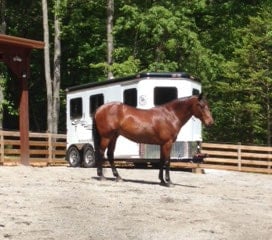
How Much Does a Horse Trailer Cost?
A brand new horse trailer costs between $15,000 to ten times or more of that amount, while a medium-sized used horse trailer ranges between $2,000 to $30,000. The price of a particular horse trailer is always a combination of factors:
-
Size and hauling capacity
-
Design and layout
-
Materials and assembly quality
-
Condition and appearance
-
Hitch type and body style
-
Brand and model
-
Additional safety features and amenities
-
Location and market demand
For example, a typical 2-horse step-up horse trailer with some additional options, depending on the make and model, can cost anywhere between $15,000 and $30,000. The price tag of a 3-horse slant load gooseneck horse trailer with living quarters and plenty of additional perks can easily pass the $150,000 mark. A bumper-pull LQ horse trailer’s price can vary a lot - such trailers can be worth anywhere between $30,000 and well over $100,000, based on the factors listed above.
What is the Most Expensive Horse Trailer?
The most expensive horse trailer is reportedly a slant load, 3-horse, 31-foot Bloomer, with a whopping price tag of $999,999. This price is more of an exception, though. Most luxury gooseneck LQ trailers come nowhere near that amount and are usually around the $150,000 mark.
What is the Cheapest Horse Trailer?
The cheapest horse trailer you could find today is an Equi-Trek Apollo, a UK-manufactured model with a starting price of under $10,000.
Horse Trailer Construction, Materials, and Safety Standards
As a prospective owner, understanding the manufacturing process of horse trailers is another crucial step in a prospective buyer's journey. Most horse trailers are almost always manufactured using similar manufacturing processes and techniques. Still, implementing different materials, structural design, and technology results in a better-than-average product in terms of safety and quality. Knowing these things can protect you and your horses from potential safety hazards, prevent expensive maintenance costs, uphold resale value, and avoid legal problems or fines associated with non-compliant, unfit trailers.
Each horse trailer is built on top of a rigid frame. The shell uses either a steel or aluminum structure that’s wrapped with aluminum, steel, or composite sheets and roof. Depending on the materials, the price of the final product can vary a lot, and aluminum horse trailers are almost always the more expensive, yet better option because of their lower weight and longevity. A major innovation in this sector is Double D Trailers’ 3D-printed horse trailer that’s currently in its final development phase. This trailer uses materials such as polymers and carbon fiber. The latter two are exceptionally strong and durable, particularly carbon fiber - it’s five times stronger than steel, and five times lighter than it.
Safety should be the main priority when designing and building a horse trailer. Every step of the process counts: using the correct materials, ensuring structural rigidity, making sure weight distribution is on point, keeping tongue weight low, and designing the kind of layout and interior space that would enhance accident safety. The latter involves secure horse stalls, additional safety equipment, and a well-planned escape route. To achieve all that, a horse trailer manufacturer faces several challenges, some of which we’ll discuss below.
What Are Horse Trailer Safety Standards?
Horse Trailer Safety Standards are a set of regulations and guidelines designed to ensure the safe and humane transportation of horses. They address structural integrity, weight distribution, flooring, braking systems, appropriate road safety lighting, towing safety, and secure access points. Upholding these standards safeguards horse well-being during travel and ensures the safety of other road users.
Here are seven important horse safety standards to consider:
Structural integrity
A horse trailer designed with structural integrity ensures that horses are protected during transportation and in the event of a road accident. This requires having a sturdy frame, axles, and hitching system, alongside a strong enough body to withstand the elements or a collision.
Size and Weight
Every trailer needs to be sized right, according to its class and purpose. Weight distribution and having enough load capacity are key factors for a trailer’s stability, as well as making sure there’s no excess tongue weight.
Safe Stalls
Safe horse trailers feature thoughtfully designed dividers and adequate ventilation, all contributing to the horse's well-being during transportation. Horse stalls are equipped with durable, non-slip flooring materials, along with insulated and padded walls to maximize horse comfort.
Brakes and Lighting
Part of horse trailer safety standards include being equipped with bright lights, including brake lights, turn signals, and interior lights. It is paramount that the electrical elements, including the trailer's brakes and emergency breakaway system, are consistently maintained in good working order.
Hitching and Coupling
Using safety chains or cables as a backup in case of a hitch failure is part of horse trailer safety standards.
Wheel Size and Fitment
Any safe horse trailer features tires and rims that are properly sourced, sized, and inflated, with enough tread depth. Tightening the lug nuts correctly to prevent accidents caused by wheel detachment is equally important.
Emergency Exit Routes
Safe horse trailers come with easily accessible emergency exits, such as side doors or side ramps. Having a well-designed escape route to allow quick evacuation of humans and horses in case of an emergency is always a top priority for horse manufacturers and owners.
What Materials Should Be Used to Make a Safe Horse Trailer?
The most popular materials used for the manufacturing of a horse trailer are steel, aluminum, and composite materials, such as fiberglass. Some trailers are safer and longer-lasting than others depending on the design, the build process, and choosing proper materials. This is the result of using alternatives, such as the Z-Frame technology patented and utilized by Double D Trailers. It uses zinc alloy to ensure a lightweight, yet strong structure that’s sturdier than aluminum and lasts way longer than steel.
Aluminum Horse Trailers
Aluminum horse trailers incorporate aluminum alloys as a structural part of the frame or body, or both. It’s the most commonly used material in this industry. The popularity of aluminum horse trailers comes from their lower weight and their longevity when compared to steel alternatives. The prices of aluminum trailers are higher, but the less maintenance required compensates for that.
Aluminum Horse Trailer Pros:
-
Better weight/load capacity ratio
-
Longer lifespan because aluminum doesn’t rust
-
Easier maintenance
-
Higher durability
-
Better stability thanks to the lower center of gravity
Aluminum Horse Trailer Cons:
-
Worse flexibility than steel trailers
-
More easily deformable aluminum walls
-
Worse safety compared to steel trailers
-
Steeper prices than comparable steel trailers
How Safe Are Aluminum Horse Trailers?
Aluminum horse trailers are as safe as steel ones when they comprise a steel frame and shell structure, unlike all-aluminum models, where the material needs to be processed to be stronger than alloy steel. The safety of a horse trailer depends on several factors, including incorporating the right trailer materials.
Steel Horse Trailers
A steel horse trailer incorporates steel for both the frame and shell, resulting in high structural stability. Steel trailers are flexible and durable, meaning that it doesn’t experience much stress. It’s cheaper than aluminum and easier to weld, therefore, steel horse trailers are almost always cheaper than aluminum ones. Steel trailers, however, require more maintenance and are often prone to rusting.
Steel Horse Trailer Pros:
-
More affordable than aluminum horse trailers
-
More flexible than aluminum horse trailers
-
Better load capacity than comparable aluminum horse trailers
Steel Horse Trailer Cons:
-
Worse lifespan because of possible rust issues
-
Harder maintenance
Is Steel Better than Aluminum for Building a Horse Trailer?
Yes, steel is better than aluminum in terms of flexibility, rigidity, and heat conduction. Steel doesn’t bend and crack; instead, it flexes and provides less heat than aluminum structures. But the proper horse trailer construction process requires advanced processing of either of these materials to provide safety, performance, and longevity.
Fiberglass Horse Trailers
Fiberglass and composite horse trailers typically use a steel frame and a steel or aluminum shell structure, wrapped with composite side walls, doors, fenders, and roof. On most such models, there is a front-mounted reinforcement panel made from metal to prevent damage. Fiberglass trailers are even lighter than all-aluminum ones, and often show the same sturdiness, but bring better longevity because they don’t rust or corrode.
Fiberglass Horse Trailer Pros:
-
Lighter weight
-
More durable materials
-
Better protection against rust and corrosion
Fiberglass Horse Trailer Cons:
-
More complicated maintenance
-
Higher prices compared to aluminum trailers
What is the Safest Alternative to Aluminum and Steel Horse Trailers?
Z-Frame horse trailers are the safest alternative to aluminum and steel horse trailers. Designed by Double D Trailers, the patented Z-Frame technology utilizes zinc and chromate to transform the durability and longevity of steel by adding special coating on both sides of metal tubing used to fabricate horse trailers.
Z-Frame Technology is the result of advanced design and specific material processing applied to manufacturing trailer chassis and stall dividers. The result is steel tubing with superb oxidation resistance and reduced heat transfer qualities. Hardly any weight is added to the processed steel components, but the increase in their strength is exceptional.
The next best thing in the world of safe metal horse trailers is Galvanneal skin. This is a type of sheet metal protected with a layer of zinc-iron coating that protects the steel from the elements.
Z-Frame Horse Trailer Pros:
-
Stronger steel tubing that’s resistant to cracks and provides less heat
-
Less added weight compared to other alloy types
-
Unprecedented rust protection
-
Increased trailer lifespan
-
Easier maintenance
-
Less expensive than aluminum equivalents
Z-Frame Horse Trailer Cons:
-
More expensive than regular steel trailers (not a substantial difference, though)
The safest alternative to aluminum and steel horse trailers is by far the groundbreaking 3D-printing technology. Polycarbonate and carbon fiber are the main materials in this case. They provide a stronger-than-steel structure that’s equal in weight or below the weight of an all-aluminum trailer. 3D-printed horse trailers are not here yet, but they are available for order.
3D-printed Horse Trailer Pros:
-
Shorter lead times compared to traditional horse trailers
-
More advanced design and features than all other trailer types
-
Lightweight and spacious
-
More durable and flexible than aluminum and horse trailers
3D-printed Horse Trailer Cons:
-
Fewer options available (for now, it’s only announced as a bumper pull model)
Is Galvalite Better Than Aluminum Horse Trailer?
Galvalite is better for the skin and other elements of the horse trailer because it’s five times more durable than aluminum. It’s more flexible as well and extends the life of a trailer. This material has been used by Double D Trailers for years, proving its advantages over time.
Horse Trailer Materials That Ensure Safety and Comfort
Considering the main purpose of horse trailers, i.e. transporting horses safely and comfortably, the most important aspects of a horse trailer are its chassis, choice of flooring, interior skin, roofing material, walls and dividers, design, and dimensions.
Best Horse Trailer Chassis Material
A horse trailer chassis, also referred to as a frame, is the strong foundation of the whole rig. It determines the rigidity of the whole vehicle, alongside the safety of the humans and horses using it. The chassis is what the shell and suspension are attached to, and it holds the weight of the rig, meaning that it needs to be flexible and strong enough, and capable of handling enough load.
The material used for building a horse trailer chassis is usually alloy steel with a different composition. Some of the best manufacturers today use special technology to protect steel frames from the elements. Double D Trailers’ Z-Frame technology mentioned above is a prime example. Composite frames have yet to enter the horse trailer scene.
Best Material for Trailer Floors
Trailer floors are crucial for the safety and comfort of horses. Steel floors rust and aluminum floors get mangled and corrode over time, not to mention how slippery they can get. This requires a special type of flooring. Many horse trailer manufacturers use wood, but it’s better to use special mats. To avoid slippery floors in any horse trailer stall, solutions such as Rumber flooring get the job done.
Best Interior Skin Material for a Horse Trailer
The best interior skin material for a horse trailer is Galvalite. While it looks and feels like aluminum, it’s far superior. Galvalite lasts longer, and it’s more durable than aluminum, and the two types of materials weigh just about the same.
Safest Horse Trailer Roof System
The safest trailer roof system comprises composite materials. Unlike aluminum, which is still widely used, composites don’t absorb and conduct heat as much. Aluminum roofs are neither the safest nor the most comfortable solution for your horses. Fiberglass roof systems such as the SafeBump solution incorporate some of the safest horse trailer roof materials.
Safest Wall System for a Horse Trailer
The safest system for the walls of a horse trailer requires having several qualities at once: rigidity, insulation, and lightweight. Many horse trailers feature aluminum side walls, and some even have as little as a single layer. This is not a safe option. Having Galvalite walls, or at least an additional insulation layer, is important for the comfort and safety of the horse trailer.
Safest Interior Divider for a Horse Trailer
The ultimate interior divider for a horse trailer is made from alloy steel. Aluminum ones are not guaranteed to protect your horse in case of an accident because they might break in the weakest spots – the welds.
The SafeTack Horse Trailer Design
The SafeTack horse trailer design, patented by Double D Trailers, solves a long-lasting problem: the stationary tack room in the back corner of conventional slant load trailers that results in a narrow rear entrance for horses and humans. The potentially dangerous inconvenience has been eliminated by the SafeTack system, which introduced a moving tack compartment that swings out, revealing full access from the rear loading point of the trailer.
Horse Trailer Dimensions to Know Before Buying
The average dimensions of a straight load 2-horse bumper pull trailer (one of the most popular types) are as follows: at least 6 feet wide, 10 feet deep, and 7.5 feet tall. The correct trailer size is determined by the weight and measurements of your horse. The roof should be at least 10 inches above the horse’s head for safety and comfort reasons.The following measurements are indicative.
Most horse trailer manufacturers can customize a trailer to meet your specific needs, including wider and longer horse stalls with more headroom and additional space for freedom of movement and comfort.
What are the Different Sizes of Horse Trailers?
The different sizes of horse trailers correspond to the number of horses they can accommodate and the related needs of owners. For example, single-horse trailers are for one horse, while two-horse and three-horse trailers are for multiple horses needing more space, and multi-horse trailers are for four or more horses, often utilized for commercial purposes or group events. The size of the trailer not only determines its capacity but also impacts its maneuverability, towing requirements, and cost.
Horse Trailers Weight to Consider Before Buying
The weight of a horse trailer mostly depends on its type. For example, a 2-horse bumper pull trailer can weigh anywhere between 2,300 and 4,000 pounds. Bumper pull horse trailers are usually much lighter than goosenecks. The latter can easily weigh north of 6,000 pounds. The heaviest horse trailers are always semi-truck models. The exact weight depends on the materials used and any additional features it could be equipped with. When fully loaded, such a trailer could weigh as much as 8,000 pounds.
Why Does a Horse Trailer Weight Matter?
Horse trailer weight matters a lot because it determines several aspects related to moving your horses. Choosing a horse trailer with the ultimate weight/capacity ratio is crucial because you need to make sure it can carry your horses without issues or compromises with safety and comfort. You also should make sure your towing vehicle is suitable. Checking the tongue weight of bumper pull horse trailers is very important in terms of safety and easy towing. For example, a particular horse trailer model should weigh a lot less than a similar horse trailer with living quarters. The latter feature adds considerable weight to the trailer and may increase the tongue weight as well.
An important aspect related to the weight of your horse trailer is the gross vehicle weight rating. GVWR refers to the maximum legal weight of a fully equipped and loaded rig. This safety standard should never be exceeded for safety and legal reasons. Note that some horse trailers could require special licenses to be towed, depending on the jurisdiction, the towing vehicle, and other factors.
Legislation and Licenses to Know When Buying a Horse Trailer
The licenses needed for pulling a horse trailer vary between different states. In most cases, you won’t need a commercial driver’s license if the combined weight of your fully loaded horse trailer and towing vehicle is under 26,000 pounds. This means that almost all standard horse trailers can be towed safely without the need for additional licenses. It’s best to check the local legislation in your home state.
It’s important to make sure your rig meets its required GVWR. To check if you didn’t exceed the maximum legal weight, authorities may perform routine checks that involve going through weigh stations.
What is the Horse Transportation Safety Act?
The Horse Transportation Safety Act (H.R.921) introduced an important amendment to the United States Code’s Title 49 in 2021. This change banned using double-level animal trailers, thus prohibiting the transportation of horses in such an inhumane manner.
Horse Trailer Licensing and Registration
Most U.S. states require horse trailers to be registered for legal road use. The registration requirement is usually based on two factors: the weight of the trailer and whether it’s intended for commercial purposes or not. To be certain if you are supposed to register your trailer or not, contact your local DMV.
Towing Laws and Regulations
Except for registering your horse trailer if and where needed, consider the rest of the important federal and state towing laws and regulations. If you intend to buy a trailer for personal use, then you won’t be bothered by the regulations regarding commercial vehicles.
When you’re certain your driver’s license covers the category of the towing vehicle you’ve selected for your new trailer, you’ll need to insure the latter. The insurance cost depends on the state you live in and the type and size of the horse trailer.
The most important aspect of properly licensing your trailer for legal road use is safety. Most states require various attributes, such as emergency chains backing up the trailer hitch, alongside clearance and trailer lights and an electric breakaway system.
Animal Welfare Laws That Horse Owners Should Know
1. Horse Protection Act: This federal law prohibits transportation of sored horses to shows and events of any sort, for both personal or commercial gain.
2. FMCSRs: The Federal Motor Carrier Safety Regulations issued by the Federal Motor Carrier Safety Administration (FMCSA) are not valid for non-commercial horse transportation. This means that there should be no compensation for the said transportation.
Different Components of a Horse Trailer
The different components of a horse trailer are divided into 3 sections:
-
Interior section
-
Exterior section
-
Safety equipment and features
Each of them affects the trailer’s safety and comfort during hauling, not to mention their importance and relevance to the several federal, state, and local requirements related to using a horse trailer legally.
What are the Interior Sections of a Horse Trailer?
The interior sections of a typical horse trailer are horse stalls, tack room, dressing room, living quarters, loading door and ramps, and storage compartments.
Stall Area
The horse stall area is the space intended for horses to travel safely and comfortably. Therefore, it’s the most important section of any horse trailer. It needs to be wide, tall, and long enough to fit the number and breed of horses it’s supposed to. A properly designed horse stall is crucial for the safety and comfort of horses, therefore, it must feature all the available perks: padded walls, secure stall dividers, anti-slip flooring, proper ventilation, an emergency escape door, and wide enough loading/unloading doors and ramps.
Tack Room
A tack room is the designated space for storing riding tack and accessories. This is an essential part of any horse trailer. It should be big enough to store the tack needed for the horses in the stall area, and it should be easily accessible. The SafeTack solution for slant load trailers, for example, provides plenty of space and allows for easy loading and unloading, thus enhancing the horses’ safety.
Dressing Room
The dressing room inside a horse trailer is where riders and handlers can change outfits comfortably and in privacy. It’s usually located in the front part of the trailer. It’s also isolated from the stall area, and it's meant for changing outfits and possibly storing them alongside tack and other gear.
Living Quarters
Living quarters refer to the part of a horse trailer that provides comfortable sleeping and dining facilities for people. Well-designed LQ horse trailers offer all the comforts of home, including a bedroom area, a kitchenette, a bathroom with shower, a dining area, wardrobes and storage cabinets, and more. The possible additional features include soft walls, Wi-Fi, air-conditioning, a fridge, and plenty of other perks. The size of a horse trailer with living quarters depends on the trailer type and the client’s preferences.
Loading Door or Ramp
The loading doors and ramps of a horse trailer are the features allowing horses to get on board. They are mounted in different configurations, depending on the trailer type, the position of the horses during hauling, and the preferred loading/unloading direction. Rear and side ramps are the most common types, and there is almost always an escape door in the front part of the stall.
Storage Compartments
Storage compartments are used for storing horse equipment, belongings, and other gear that needs to be transported outside of the horse stall or tack rooms. Most often, storage compartments found in a trailer include cabinets, tack trunks, and wall organizers. Equestrians know that the more storage compartments a horse trailer has, the better organized the interior would be. There are plenty of different storage solutions to consider, such as hay bale racks, wall organizers, dressing room cabinets, and more.
What are the Exterior Parts of a Horse Trailer?
The exterior sections of a typical horse trailer include the trailer hitch, wheels and tires, suspension system, brakes, lights, walls and roof, doors and windows, ramps/step-up doors, and awning.
Most of the exterior parts of a horse trailer directly affects its safety, therefore, they all matter equally. Proper exterior design and quality-made components are key to the trailer’s longevity and performance.
Trailer Hitch
A trailer hitch is the device used to attach the trailer to the tow vehicle. There are three types of horse trailer hitch designs, arranged in relevance to the load they must carry: weight carrying, weight-distributing, and gooseneck. Choosing a trailer with either of them depends on factors such as the towing vehicle you have and the number and size of horses you want to haul. Regardless of which type you end up with, you need to maintain it properly, and its load capacity (tongue weight) should always be considered.
Wheels and Tires
The wheels and tires of a trailer are the only exterior parts of the trailer in contact with the road surface, meaning that they play a major role in braking, handling, fuel economy, and overall performance. Therefore, the wheels and tires of a horse trailer are among its primary safety features, as long as they are the right size, properly inflated, and with plenty of tread,
Suspension System
The suspension of a horse trailer consists of axles, dampers, coil springs, hubs, and other components designed to carry all the load and take care of road stability. There are various suspension setups available, and they differ based on the type of trailer they must support. Ride comfort is another factor to consider, especially when it comes to LQ horse trailers.
Brakes
The braking system of a trailer is used to decelerate the trailer. It works in sync with the braking system of the tow vehicle, and it’s a primary safety feature. It’s powerful enough to bring the trailer to a halt and prevent sliding to the side.
Lights
Exterior trailer lights are required by law and comply with the basic safety standards regarding horse trailers. They differ from interior lights because of their purpose and positioning. Exterior lights include indicators, loading lights, and hazard lights. Having bright taillights, corner lights, and side markers is always a must. A fully functional electrical system that’s compliant with all federal and state safety standards is sufficient for the maximum safety of the trailer.
Exterior Walls and Roof
The exterior walls of a horse trailer protect the horses inside from the elements and from harm in case of a road accident. Therefore, both elements are strong enough to withstand an impact and are properly insulated to prevent the interior from heating up. The latter can cause anxiety in the horses and dehydrate them, which is dangerous during transportation.
Doors and Windows
Horse trailer doors allow for easy loading and unloading, while the windows provide extra light, comfort, and even ventilation when needed. Both elements are placed strategically because they can serve as an escape route in case of an emergency. Loading/unloading doors should always be wide enough to reduce stress in horses while getting in and out of the trailer, and the side windows should introduce enough light. Horses don’t like to be crammed into dark spaces with limited space for movement.
Ramp/Step-Up
Step-up gates and ramps are the two types of horse trailer entry points: the former requires horses to step into the trailer, and the latter provides them assisted entry thanks to ramps. Some ramps are too steep and slippery, which may cause issues. Step-up trailers can sometimes be too high for older horses to get into, so the safer choice for your horses should be based on their size, behavior, age, and health condition.
Awning
Horse trailer awnings resemble sun shades that attach to the side of the horse trailer. This is one of the non-essential, but useful exterior parts of a horse trailer. Awnings can provide additional protection for your horses by adding extra space during events.
Top Safety Features to Know When Buying a Horse Trailer
The most important safety features of a horse trailer are the braking system, the exterior lights, the sturdy dividers, soft padding, and insulated roof and walls, and the side windows. These features guarantee that both horses and humans are safe from harm in every situation. Most of these features are simple, yet incredibly efficient ideas and perks that could make all the difference during an emergency.
Tie Rings
Tie rings are used for securing lead ropes or tack ropes. They are a vital part of any trailer’s equipment. The rings are placed strategically so that, once tied, a horse could not turn to its side into an uncomfortable and potentially dangerous position.
Interior Padding
Interior padding acts like a cushion and prevents horses from injuries. Some trailers offer nothing but bare aluminum interior walls, but safety requires wall padding that’s thick and soft enough. Opting for interior padding is always a good idea, as it protects your horses from accidents.
Non-slip Flooring
Non-slip floors’ specific surface allows horses to go in and out of the trailer safely. Aluminum floors get mangled easily and corrode over time, not to mention how slippery they can get. Wooden flooring is a better solution, but installing precisely cut floor mats, or better yet, Rumber flooring, which is the ultimate solution.
Emergency Exits
Emergency exits guarantee the safety of both horses and humans, regardless of the situation. Having an escape route (a door or a window) regardless of the type and size of trailer you choose is always a must.
Safety Chains
Safety chains ensure a stable connection between the horse trailer and the tow vehicle in case of hitch mechanism failure. In many states, safety chains are required by law. Having safety chains and cables attached to the towing vehicle is just another simple, yet effective precaution in case there’s an issue with the tow hitch or its breakaway system.
Electric Breakaway System
This system triggers the electric brakes of the trailer in case its coupling breaks free and the safety chains cannot restrain it. The way the system works as an emergency brake.
Proper Ventilation
Ventilation allows for correct airflow inside the horse stalls. During long travels, the temperature inside a horse trailer can become dangerously high, potentially dehydrating horses. Therefore, proper ventilation should be part of the trailer’s features. Some manufacturers offer additional trailer fans to keep horses cool in the sizzling summer days.
Stall Dividers
Stall dividers are designed to protect horses from injuries by keeping them separated. They would be the first thing a horse would be pinned to in case of a road accident. Stall dividers must protect the horse while keeping the animal in place.
Lighting
Lighting provides additional comfort and safety to horses by providing a way to reduce the solitary confinement effect they often experience. Cleverly designed interior and exterior lighting makes all the difference in the mood of your horse during loading, unloading, and transportation. They don’t like confined, dark spaces, and additional interior lights could help with that. Proper lighting also should be installed on the trailer’s exterior to aid loading and unloading horses when it’s dark.
Door Latches
Door latches are used for securing horse trailer doors. By having them mounted on the rear or side doors, you eliminate the need for padlocks.
Essential Horse Trailer Accessories to Consider Ordering
The essential horse trailer accessories to consider are as follows:
-
Cowboy/cowgirl shower
-
Auxiliary battery
-
Wi-Fi
-
Water tank
-
Wall grid organizers
-
Trailer ties
-
Hay bale storage space
-
Portable ramps
-
Tack and gear organizers
-
Trailer cameras
-
Soft walls
-
Solar panels
Some of the must-have horse trailer accessories you could opt for are not related to safety. However, they can enhance comfort, practicality, and convenience significantly while on the go.
Buying a Custom Horse Trailer
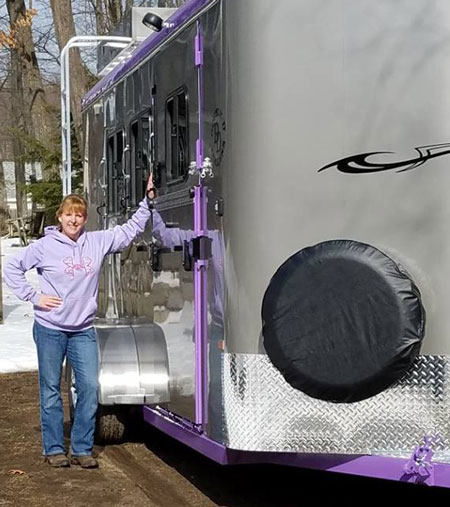
The best thing about custom-ordering a horse trailer is the almost unlimited variety of additional features that can be added during production. This aspect makes custom trailers even more different from all similar classic production line models.
How to Order a Custom Horse Trailer
Custom-ordering a horse trailer requires a lot of planning and preparation that becomes part of the manufacturing process. For example, a horse trailer manufacturer like Double D Trailers encourages clients to participate in the design and building stages of their new custom horse trailers by sharing preferences, insights, ideas, and more.
The typical ordering process for custom horse trailers looks like this:
Step 1: Learn all you can about horse trailers or find a manufacturing company or consultant to determine the right type and
Step 2: Study and compare different manufacturers based on their current model lineup and feedback from their existing clients.
Step 3: Determine exactly what type of safety features and layout would work best for you.
Step 4: Once you’re ready to order, discuss the initial design and all the features you want the final product to be equipped with.
Step 5: Sign a contract after you receive an offer and an estimated delivery date.
Step 6: Depending on the manufacturer, you could make changes during production, if possible.
What are the Pros and Cons of Customizing a Horse Trailer?
Being able to custom-order a new horse trailer is one of the best experiences ever for every horse owner. Of course, this decision comes with advantages and some drawbacks.
The pros of custom-ordering a horse trailer are as follows:
-
You get exactly what you envisioned.
-
You avoid additional costs for built-in features you won’t even use.
-
You can have your trailer built using the specific materials you prefer.
-
You’ll have access to combinations of design and layout that are not available as a ready-made, catalog-listed model.
The cons of custom-ordering a horse trailer are as follows:
-
Custom trailers almost always cost more than a comparable production alternative.
-
Sometimes, it takes more than usual to deliver a custom-built horse trailer order.
Quick Tips on Buying Used Horse Trailers
Some people prefer to go out and find a used horse trailer that’s an almost exact match to their preferences and expectations. There are a few good reasons for that:
-
Used horse trailers are far more affordable than equivalent new ones.
-
Second-hand trailers are available for purchase instantly, which is not always the case with new ones.
What matters the most is to find as many tips as possible on buying the right used horse trailer. There are plenty of things to check in a second-hand rig: solid frame, zero rust, working electrics and brakes, and so forth.
Basic Horse Trailer Maintenance Tips
The basic horse trailer maintenance tips mostly relate to safety, even when they’re seemingly not. The required maintenance of a particular trailer depends on its type, size, incorporated materials, layout, and other factors.
These are the two most important tips you should follow:
1. Clean the trailer regularly – both inside and out: A detailed cleaning should follow a long or short road trip. This eliminates contamination and mud from the frame and shell, thus preventing rust. The same goes for the interior – for example, aluminum horse stall floors corrode because of horse urine, which requires frequent pressure washing.
2. Arrange for regular service visits: Your trailer needs to be mechanically sound, therefore, you shouldn’t skip the frequent visits to a service shop where they should inspect your trailer hitch, tires, brakes, suspension, electrics, lights, and more.
How to Tow a Horse Trailer
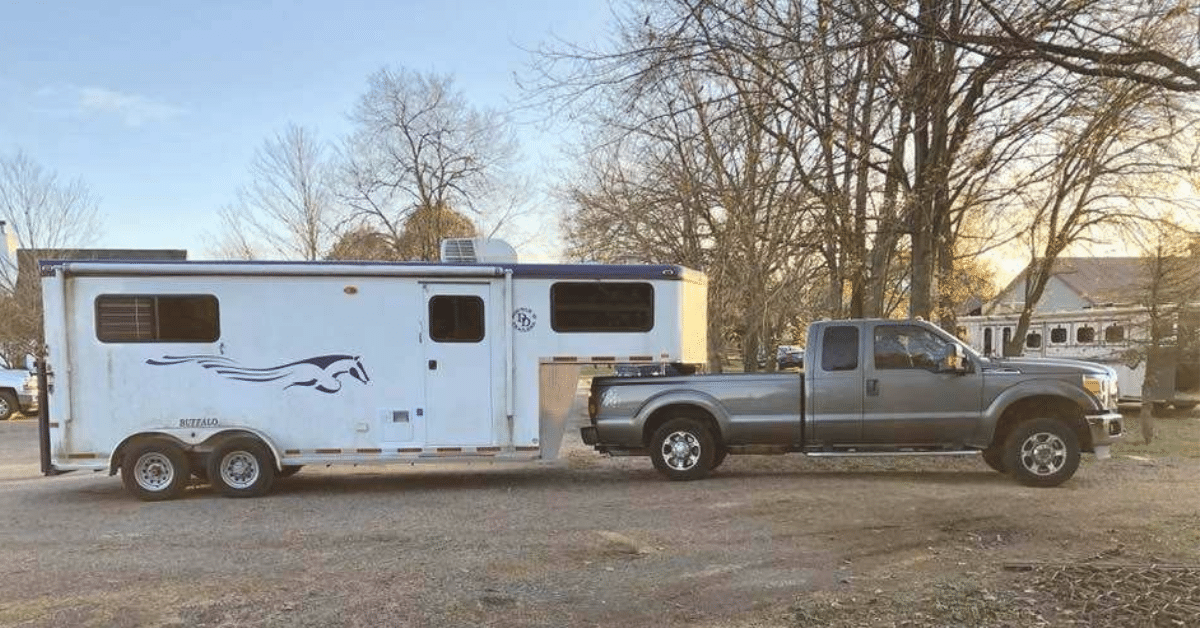
Step 1: Pick the right tow vehicle for your new trailer. This first and most important step in safely towing a horse trailer. The best choice depends on the trailer’s dimensions and tongue weight:
-
Small and mid-sized bumper pull horse trailers can be towed with regular vehicles, SUVs, and pickup trucks
-
Larger bumper pull horse trailers, such as 3-horse LQ models, might require bigger towing vehicles because of more tongue weight
-
Gooseneck trailers require adequately sized pickup trucks with an installed hitch ball mount in the bed
Step 2: After making sure you have the right vehicle to tow your new or second-hand horse trailer, consider these aspects before hitting the road:
-
Check all systems of the trailer before driving away, even if it’s a brand-new rig. This includes the towing hitch, electrics, ramp and door latches, tires, and other features
-
Make sure you load the horses properly and tie them down
-
Adjust your mirrors and driving position and keep in mind the weight of the rig you’re about to tow
-
Take off slowly, avoid sharp turns and keep your distance to prevent emergency braking
-
Stop in case your horses are anxious or you’re experiencing strong side winds
-
Perform occasional stops to check on the horses
What are the Best Trucks for Towing a Horse Trailer?
The best trucks for towing a horse trailer are the ones that have enough towing capacity for the rig you intend to buy. They should also handle the tongue weight of the trailer, meaning that power and load capacity are not enough.
2WD/RWD (two-wheel-drive or rear-wheel-drive) trucks and SUVs may sometimes be capable of towing your horse trailer, depending on its size and dimensions, but opting for a 4x4/4WD (four-wheel-drive) vehicle is better in most cases, especially if your living area experiences harsh weather often.
When purchasing a towing vehicle or a new trailer to attach to your existing truck, you need to check for important specifications other than load capacity and tongue weight capabilities:
-
The Gross Vehicle Weight Rating (GVWR) refers to the maximum loaded weight allowed for the particular vehicle. This includes all the passengers, equipment, and trailer tongue weight.
-
The Gross Combined Vehicle Weight Rating (GCVWR) stands for the maximum combined amount of weight allowed for your fully loaded tow vehicle with the horse trailer attached to it.
-
Finally, the Gross Axle Weight Rating (GAWR) tells you the maximum allowed load on the tow vehicle’s axles. You should never exceed it, as it could lead to excessive wear and damage, and that can cause an accident.
There are three popular categories of trucks to know:
-
Half-ton trucks with a load capacity of approximately 1,000 pounds on average: Ford F150, Dodge Ram 1500, Chevrolet Silverado 1500, GMC Sierra 1500, Toyota Tundra
-
Three-quarter ton trucks with a load capacity of approximately 1,500 pounds (heavy duty class): Ford F250, Dodge Ram 2500, Chevrolet Silverado 2500, GMC Sierra 2500
-
One-ton trucks with a load capacity of approximately 2,000 pounds: Ford F350, Dodge Ram 3500, Chevy Silverado 3500, GMC Sierra 3500
Where to Buy a Horse Trailer
You can buy a horse trailer in at least three ways, depending on the supplier’s policy and your personal preferences regarding convenience:
-
From a horse trailer dealer’s lot or a reseller
-
From a manufacturer
-
From an online sales platform
Some manufacturers prefer to sell their horse trailers directly, mostly online. Double D Trailers, for example, offer a nationwide flat shipping rate for all trailers ordered online, which is highly convenient.
Horse Trailer Dealers
Purchasing a horse trailer from a dealer requires some research. You should only trust reputable dealers with a strong background and plenty of positive customer feedback. Some examples include:
-
National Trailer Source: NTS is a popular brand, operating across 10 locations in Texas, Arizona, Oklahoma, and Kansas. It represents many of the popular U.S.-based horse trailer manufacturers.
-
Dixie Horse & Mule Co.: DHM Co. is a large-scale dealer of horse trailers and tractors offering a good inventory online and at two locations in Alabama.
-
Transwest: Another popular dealer specializing in horse and livestock trailers, alongside RVs and trucks. Transwest sells its inventory online and in a couple of locations in Colorado and Kansas.
What are the Benefits of Buying a Horse Trailer From a Dealer?
The benefits of buying a horse trailer from a dealer include the possibility of finding the perfect trailer and buying it on the spot with no delays. Other perks of choosing this method may include good financing options, great deals, possible servicing preferences, and additional warranty.
Searching online for "horse trailer dealers near me” should bring out plenty of information about dealerships in your area. Suggested keyword searches: "horse trailer dealers in Texas", "horse trailer dealers in NC", and so forth. If you know them already, it’s best to check them all out and compare the offers on equally matched trailers they’d give you.
What are the Risks of Buying From a Dealer?
The risks involved in purchasing a horse trailer from a dealer include hidden defects or having no warranty when it comes to second-hand units. Buying a horse trailer “as is” without an extended warranty is a risk. Suspiciously tempting prices can also indicate issues.
Horse Trailer Manufacturers
Horse trailer manufacturers sometimes sell their products directly, which can have several benefits, including ease of communication, possible customization options, and better prices.
Horse trailer dealers are representatives of some manufacturers or simply resellers, based on the company policy. You can find a good deal when purchasing your trailer from either of these two sources. It all comes down to your search criteria and the specific details of the deal you’re after.
How to Choose a Trusted Horse Trailer Manufacturer?
Choosing a trusted horse manufacturer is a simple, yet sometimes tedious process because it involves a lot of research and comparison.
First, learn everything you can about the industry. This is how reputable horse trailer manufacturers eventually stand out from the rest as part of your research.
Next, find all the client feedback possible: customer opinions realistically show the quality of any product. Therefore, you need to check out specialized reviews, blogs, and forums dedicated to the equestrian world and, more particularly, to horse trailers.
The final step is to recognize the perfect trailer type for you and gather comparable offers from different manufacturers.
Is Buying a Horse Trailer from the Manufacturer Better than a Dealer?
Yes, buying a horse trailer from the manufacturer is better than from a dealer in most cases. If a reputable manufacturer is local to you, then landing a good deal on the horse trailer you want should be easy, not to mention the possible customization options you can take advantage of when available. Most horse trailer manufacturers offer custom features to a significant extent.
Online Platforms to Buy a Horse Trailer
Specialized online platforms for buying a horse trailer exist, and they are much different from common sales pages such as Craigslist. The difference between such a platform or a plain online forum and an online horse trailer sales platform is enormous: the latter provides the same experience as visiting a dealership without the hustle and bustle of strolling through trailer lots. If you find a reputable online sales platform dedicated to horse trailers and equipment, you’d be dealing with a professional company that should take care of all the details: financing, inspections, and delivery. Plus, buying a new trailer this way rarely affects the price, meaning that you won’t pay more compared to getting the trailer from the dealer or manufacturer. Every situation is individual.
What are the Benefits and Risks of Shopping for Horse Trailers Online?
The benefits of shopping for horse trailers online include an almost unlimited variety of brands, types, and offers. You can browse nearby and out-of-state dealers and arrange for delivery with a few clicks or phone calls. Plus, you can get financing and possibly find the trailer of your dreams at a good price.
The drawbacks of shopping for horse trailers online are related to possible scams or hidden issues when it’s a used rig. There’s usually no additional warranty as well, and there could always be negative surprises when purchasing a trailer that you’ve never seen in person. Before buying a trailer online, you need to be certain about every detail related to it. Ordering a trailer that’s not of good use to you should never be allowed. Using a trailer finder to tailor the perfect trailer for you is always a good idea.
Popular Horse Trailer Brands
Most of the popular horse trailer brands are dedicated to manufacturing, selling, and customizing horse trailers. Finding a reputable brand is the only way to guarantee safe horse transportation, and this requires you to find sources that review horse trailer brands and compare them head-to-head.
All popular horse trailer brands stand out from the rest thanks to the quality, practical, and convenient trailers they design, build, and deliver.
10 of the most popular horse trailer brands in the U.S. include
-
Double D Trailers
-
Featherlite Trailers
-
Cimarron Trailers
-
Trails West Trailers
-
Sundowner Trailers
-
Exiss Trailers
-
4-Star Horse Trailers
-
Bison Horse Trailers
-
Lakota Horse Trailers
-
Logan Coach Trailers
Double D Trailers
Double D Trailers is a North Carolina-based horse trailer manufacturer focused on selling, manufacturing, and customizing bumper pull, gooseneck, and living quarters horse trailers of the highest safety standards. After the first DDT trailer was sold in 1997, the company launched several patented innovations over time, such as the Z-Frame technology, SafeTack, SafeBump, SafeKick, and the upcoming world’s first 3D-printed trailer.
Featherlite Trailers
Featherlite Trailers specializes in manufacturing all-aluminum trailers of all sorts, including horse and livestock trailers. Its history began in 1973 in Oklahoma by introducing the first all-aluminum gooseneck horse trailer. In the next couple of decades, Featherlite expanded its business by adding three new manufacturing facilities.
Cimarron Trailers
Founded in 2000 in Oklahoma, Cimarron quickly grew popular as a brand thanks to its quality gooseneck horse, livestock, LQ, and cargo trailers. The company is 100% guided and owned by its employees.
Trails West Trailers
Trails West Trailers was established in 1987 in Idaho. This manufacturer specializes in building horse trailers, living quarter trailers, and stock trailers, but also offers additional models, such as snowmobile trailers.
Sundowner Trailers
The roots of Sundowner Trailers traces back to 1976. The Oklahoma-based manufacturer is a pioneer in building aluminum horse trailers, and eventually offered an array of bumper pull and gooseneck horse trailers.
Exiss Trailers is another well-established trailer manufacturer based in Oklahoma. Since 1994, the brand has been specializing in building affordable aluminum trailers, specifically horse, livestock, and low-profile stock trailers.
4 Star Trailers
Four associates founded the 4 Star Trailers brand in 1984 in Oklahoma. By 1990, half of them left the company, but it continued to exist. Today, this manufacturer offers custom-built horse, stock, and cargo trailers.
Bison Horse Trailers
Based in Indiana, Bison Horse Trailers have been building LQ horse trailers since 1984. The company specializes in gooseneck living quarters horse trails, with three models in its current range.
Lakota Horse Trailers
Lakota is another well-known brand that specializes in gooseneck living quarters horse trailers and livestock trailers. It was founded in 2005 in Indiana, and now offers a few different models in each of the two categories.
Logan Coach Trailers
Logan Coach Trailers began its journey in 1985 in Utah. Since its inception, this brand has been focused on building gooseneck trailers in two main categories: horse and livestock trailers alongside sports & camping trailers.
Worst Horse Trailer Brands
The worst horse trailer brands are hard to distinguish, so it makes much more sense to pinpoint the worst horse trailer flaws instead. Knowing all of them should help you avoid brands that consistently allow such flaws and you’d be able to steer away from them instantly.
The worst horse trailer brands typically allow obvious flaws such as thin walls, roofs, and floors that allow little to no protection for horses, alongside poor assembly quality, restricted airflow and vision, design flaws that interfere with easy and safe loading and unloading, and plenty of other downsides.
History of Horse Trailers
The history of horse trailers begins in the 18th century. The first evidence of a horse to be purposely transported dates back to 1771 when Eclipse, a legendary racehorse whose genes shaped the Thoroughbred breed, was transported in a modified, horse-drawn carriage due to his bad feet. In the early 1800s, horses were frequently transported to racetracks using various modifications of cattle carts instead of being ridden there. This was done to save the horses’ strength for the upcoming event, so it was worth the effort to modify common carriages for that specific purpose.
The intriguing horse trailer history goes through numerous innovations and ideas that were dropped off, such as the motorcycle horse transportation sidecar models. People began to learn the importance of proper horse transportation, and some of them wanted to invest in a horse trailer as soon as the latter began evolving as an industry. The first true horse trailers that resemble present-day models were launched after WWI, and since the 1950s, they’ve been following similar layouts and designs, starting with the classic 2-horse bumper pull type.
Brief horse trailer history timeline:
1771 - first records of transporting a racehorse due to particular reasons (Eclipse)
1816 - first evidence of a racehorse being transported with a purposely modified carriage (Sovereign)
1914 – horse ambulances were created to carry injured horses to temporary hospital units
1918 – a 14-feet horse trailer carrying racehorses made a 200-mile trip between New York and Baltimore
1927 – German-based company Westfalia started manufacturing box trailers
1958 – modern-looking 2-horse bumper pull trailers hit the road
1990 – the horse trailer industry was already worth more than a billion dollars
Who Invented the Horse Trailer?
Lord George Bentinck is arguably the inventor of the horse trailer, or horse box. In 1836, his horse Elis won the St Leger race despite the odds being against him. Elis was transported using a horse box, unlike all other competing racehorses who had to travel by foot, therefore, he was in a much better shape and won with ease.
What are Railway Horse Boxes?
Railway horse boxes are modified cargo railway cars meant to haul a large number of horses between various locations, including breeding farms and racetracks. They were a popular means of transport for decades.
How Were Horses Transported by Sea?
Transporting horses by sea dates back thousands of years involving horses traveling in the dark hull or on deck-mounted canvas slings. For a very long time, horses had to travel by sea confined inside boxes stored in ships’ hulls. Large slings were an alternative way of transportation. They were placed on the deck of the ship or boat.
Until the mid-20th century, transporting horses by sea was a stressful experience for the animals, with a high mortality rate.

